Bread

I know how to bake bread and I know the recipe for basic bread that my mother used. It is one of those things that doesn’t need to be written down. Once you know it, you don’t really need to measure the flour. You use the one-cup measure more as a scoop than as a precise measuring tool. Our recipe makes three loaves of bread or three-dozen rolls.
I have three younger brothers and there were days, especially as I got into my teenage years where food disappeared from our house at a pretty rapid rate. It wasn’t being stolen, it was being consumed. In those days, mom probably would have had to bake every day to keep up with the demand. She didn’t, so we had bakery bread to supplement her home baked bread. I remember watching one morning as an entire loaf of white bead was transformed into French toast. I got one of the heels of the loaf that day. I still prefer the heels.

I know what factory bread looks like, smells like and tastes like. It didn’t make me lose my appetite for bread. But I have always preferred home-baked bread.
These days the bakeries in the stores make a lot of different breads including “artisan” breads that are closer to home baked. The process is still done on a large scale with attention to consistency, so it isn’t hard to taste the difference between bakery bread and home baked.
But we live in a time of incredible abundance and choice. The supermarket where we often pick up food on our way home from work has an entire aisle of bread with dozens and dozens of choices. Many of the “choices” don’t represent real differences. I know that because when I worked in the factory bakery, we put 18 different bags on the same bread. “Wonder Bread” is the same as the store brands, even the discount brands. It just has a different bag around the loaf.
In the midst of such abundance, we have grown careless. I read an online article that claimed that 40% of the food that American buy is never eaten. It is wasted. The same article said that a slightly smaller percentage, about one-third, of the bread purchased is thrown away. The main reason bread is thrown away is that it develops mold. The same thing that causes bread to rise and have its wonderful texture and flavor – tiny spores, leads to its deterioration. And bread mold doesn’t smell or taste wonderful. I’m quick to toss any bread that gets moldy at our house.
Commercial bakers put different chemical preservatives into bread to slow the growth of mold. I don’t recommend the experiment. It is wasteful. But if you leave a slice of home-baked bread and a slice of commercial bread out for the same amount of time, mold will form on the home-baked slice first. To me it seems unnatural for bread to go so long before developing bread. At our house home-baked bread doesn’t hang around long enough to develop mold. It takes more than a week, nearly ten days, for bread to develop mold in our dry climate around here. The bread would get stale before it got moldy. And we like to eat bread around here.
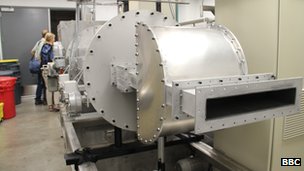 Still, a team at Texas Tech University in Lubbock, have developed a large microwave device that kills all of the mold spores in bread. Bread treated with the device has been shown to last more than 60 days without developing mold. The machine was developed for killing bacteria in meat to make it last longer and the discovery that it works on bread was a sideline to the main research that is being conducted at the university.
Still, a team at Texas Tech University in Lubbock, have developed a large microwave device that kills all of the mold spores in bread. Bread treated with the device has been shown to last more than 60 days without developing mold. The machine was developed for killing bacteria in meat to make it last longer and the discovery that it works on bread was a sideline to the main research that is being conducted at the university.Still, it is a technology worth considering. If commercial bakers didn’t have to add preservatives to the bread it would taste better. And it would be better nutrition for those who eat it as well. The recipes for commercial bread not only include chemical preservatives, but they also include other ingredients to mask the flavor of those preservatives. Remove all of those things from the ingredients list and you get bread that tastes better and is better nutrition for those who eat it. So, we will probably see the use of the special microwave machine by commercial bakers before long.
I really don’t need bread that lasts 60 days, however. It doesn’t take much planning or foresight to eat the bread before it goes bad. Careless and inattention account for more food waste than the shelf life of the products that we eat. The solution to our nation’s excessive food waste is more likely to lie in education than in more technology. I doubt that the use of the microwave technology will have much impact on the amount of food wasted.
If you really want to cut down on food waste, just have four teenage boys for dinner every night. If you don’t have boys of your own, you could always invite in the neighbors’ kids. It solves the problem of leftovers.
Copyright © 2012 by Ted Huffman. I wrote this. If you want to copy it, please ask for permission. There is a contact me button at the bottom of this page. If you want to share my blog a friend, please direct your friend to my web site.
Reading Rilke
The poetry became his lifelong quest, his refuge, his way of interpreting the world, and his way of sorting out his own beliefs. And it became his gift to generations.
Rilke studies in Linz and Prauge and Munich. He wrote his poetry in German. My classmates who studied German all came into contact with Rilke’s poems and some of them were touched and deeply moved by his words. But German is not a language that I can read and so my contact with Rilke was limited to the snippets that were translated and quoted in the books of others. But in 1996, Anita Barrows and Joanna Macy undertook an English Translation of Rilke’s Book of Hours. It is masterful. I have a copy of the 2005 edition containing expanded prefaces and a brief biography of Rilke.
Rilke does what I cannot do. He uses very few words to express complex ideas and notions. I write a thousand words a day in my blog. Rilke uses less than a hundred to say far more.
Because once someone daredto want you,I know that we, too, may want you.When gold is in the mountainand we’ve ravaged the depthstill we’ve given up digging,it will be brought forth into dayby the river that mines the silences of stone.Even when we don’t desire it,God is ripening.
I, 16
I could write pages about how the quest for God is never a one-way street. We desire to know God, but we don’t so much seek God as we are found by God. There is something in our very nature that makes us want to come into relationship with God, but there is only so much that we can do and our efforts always fall short. But there is nothing quite as exquisite as being found by God.
Having said that, Rilke said it better. “Even when we don’t desire it, God is ripening.”
The poems deserve to be read out loud and savored. And they tend to linger in my mind. I am reading them slowly, now, never more than one or two per day, so that I can savor the power of their language.
My friend and mentor, Ross Snyder, said that each of us an ecology of spirit. A human being is a web of interconnected relationships. Our beliefs and thoughts and ideas, our passions and desires – all of these are shaped by multiple relationships. I know that I have been formed by teachers that I met face to face and whose classrooms I frequented and by teachers that I have only known through the reading of their words. My library is filled with books that have become my friends. The way that I see the world is so influenced by others that I no longer know what ideas are mine and what ideas I appropriated from others. Perhaps I do not really have any independent thoughts. Perhaps no one can have any independent thoughts. From our earliest years we are shaped by our relationships with others.
Last night we took the youth from our church to a nearby ranch and into a now un-used barn. The floors were covered with hay and the place was dusty. I led them up a steep ladder into the loft where the rancher used to store baled hay. There in that dimly lit, chilly place we once again told the story of the birth of Jesus. I spoke the words of the Gospel of Luke that I have memorized. If I repeated that action each year for the rest of my life, it would not lose its power. There is nothing obviously powerful about the setting. But to me it holds powerful memories of the rancher who so recently died and who had been such a good friend. There is nothing new about the words. Even the youth have heard them over and over again. But the process is nonetheless powerful because it is the passing of ancient texts forward into a new generation.
The story did not begin with me. It does not end with me. I belong to something far bigger than myself.
When I look at the world, there are so many things that I want to change. There is suffering that is unnecessary. There are injustices that need to be righted. There are hungry people that need to be fed. There are children and youth whose lives lack connection to the heritage and stories of our people. But time rushes quickly. I am but one voice and my voice is small – even insignificant – in the vastness of the universe. I realize that my impact on the vast problems of this world will be tiny.
But it is just that the moment when I realize how small I am that I begin to sense that the real transformation doesn’t come from my effort, but that I am called to witness what God is doing.
How rich to be reminded once again that I am not alone.
Copyright © 2012 by Ted Huffman. I wrote this. If you want to copy it, please ask for permission. There is a contact me button at the bottom of this page. If you want to share my blog a friend, please direct your friend to my web site.
Of Turkeys and Eagles
Legend has it that Benjamin Franklin was upset with the design. The letter wrote to his daughter has become famous:
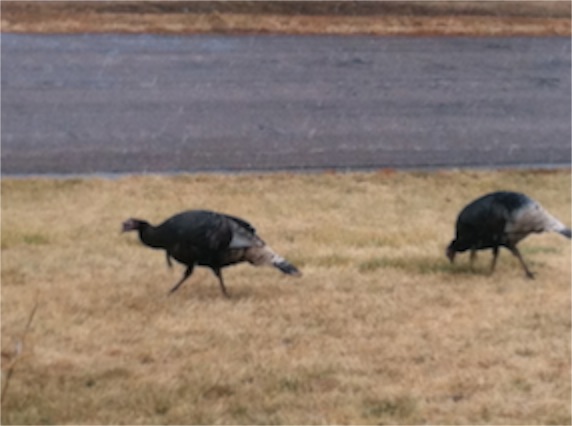
Franklin’s Letter to his Daughter (excerpt)
“For my own part I wish the Bald Eagle had not been chosen the Representative of our Country. He is a Bird of bad moral Character. He does not get his Living honestly. You may have seen him perched on some dead Tree near the River, where, too laxy to fish for himself, he watches the Labour of the Fishing Hawk; and when that diligent Bird has at length taken a Fish, and is bearing it to his Nest for the Support of his Mate and young Ones, the Bald Eagle pursues him and takes it from him.“With all this injustice, he is never in good Case but like those among Men who live by Sharping & Robbing he is generally poor and often very lousy. Besides he is a rank Coward: The little King Bird not bigger than a Sparrow attacks him boldly and drives him out of the District. He is therefore by no means a proper Emblem for the brave and honest Cincinnati of America who have driven all the King birds from our Country . . .“I am on this account displeased that the Figure is not known as a Bald Eagle, but looks more like a Turkey. For the Truth the Turkey is in Comparison a much more respectable Bird, and withal a true original Native of America . . . He is besides, though a little vain & silly, a Bird of Courage, and would not hesitate to attack a Grenadier of the British Guards who should presume to invade his Farm Yard with a red Coat on.”
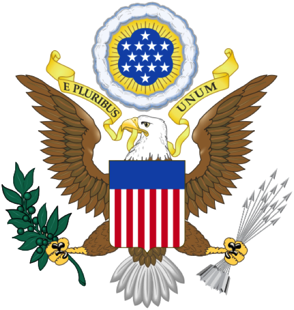
The 1782 resolution adopting the seal also described the reverse of the seal: “A pyramid unfinished. In the zenith an eye in a triangle, surrounded by a glory, proper.” It appears on the back of a one-dollar bill. The symbolism is a bit more obscure. The eye is supposed to be the Eye of Providence watching over the new nation. The motto on the reverse, “Novus ordo seclorium” (“a new order of the ages”) was taken from Virgil.
I’m not too enamored with lots of obscure symbols, but I can’t find myself agreeing with Franklin about the turkey. We get to see plenty of turkeys and a few bald eagles in our normal course of life. It seems to me Franklin is inaccurate on two counts. While an eagle is definitely an opportunist, they are capable of catching a fish on their own. I’ve watched them fishing from my canoe and I have seen them with fresh caught fish in their talons. Secondly, turkeys are not courageous birds. A flock of turkeys will surround and pick on a cat that gets too bold, but individually they will run away from the feline. Try as I will, I can’t see much intelligence in the birds. Those tiny heads don’t have any room for significant brains. They are, as Franklin comments, mostly vain and silly. I can’t imagine a turkey chasing a soldier of any country. They don’t appear to be territorial. I don’t count stupidly walking in front of a car to be run over an act of courage.
A couple of weeks ago a group of us were up in the open prairie above the Moreau River. As we finished our work we looked up and there was a beautiful bald eagle soaring in great circles above us. I’ve never seen a turkey fly much higher than the roof of the house. The eagle was beautiful in flight. Its presence above our heads seemed to be a good sign.
I told the story to a friend a couple of days later and he commented, “There must have been a dead rabbit in the coulee.” There are still a few friends of Benjamin Franklin around, I guess.
Franklin, of course, did not prevail in the argument. The US Coat of Arms is here to stay. The bald eagle is truly a magnificent bird. The turkey can continue to be a symbol of Thanksgiving. The Mayans and Toltecs of Mexico considered the turkey to be sacred. They honored them for their beauty and their cocky pride and occasionally used the bird as a symbol of virility. The Creek tribes still practice the turkey dance at fire festivals. Many tribes use turkey feathers in their rituals.
They’re welcome to come to my place. I’ve got plenty of turkey feathers floating around my yard.
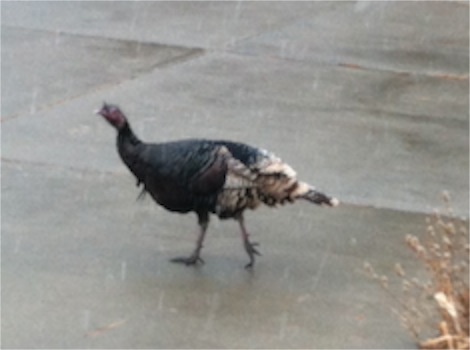
Copyright © 2012 by Ted Huffman. I wrote this. If you want to copy it, please ask for permission. There is a contact me button at the bottom of this page. If you want to share my blog a friend, please direct your friend to my web site.
The Crusades
In April of 1073, Hildebrand of Sovana was named Pope Gregory VII. He undertook the task of reforming the church and clarifying its relationship with royal authority. He almost immediately raised the ire of Henry IV, who as then Holy Roman Emperor. The argument was over how the cardinals should elect the pope. The conflict wasn’t as simple as the rules of election by the College of Cardinals, but also went to the core of the process of how bishops were raised to become cardinals and the role of the emperor in the whole process. Gregory was an advocate of the strongest papacy possible and claimed that the pope must always be a higher authority than the emperor.
The emperor declared that the papacy of Gregory was invalid. He appointed Clement III, who has been dubbed the antipope, to oppose Gregory and his reforms. Gregory, in turn excommunicated Henry not once, but twice. It all makes for pretty dry reading in church history books, but it was a time of great controversy and intrigue in the church.
Gregory died in May of 1085 and was succeeded by Otho de Lagery who was named Pope Urban II. Urban was one of Gregory’s strongest supporters and reigned as head of the church for a little over eleven years. Urban was a bit more diplomatic than Gregory but the troubles with Clement III persisted. His papacy was mostly an extension of the policies instituted by Gregory.
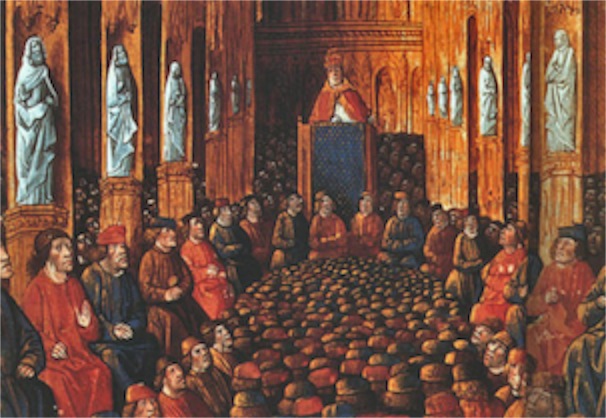
In his speech, Urban denigrated all Muslims, exaggerated stories of their anti-Christian acts, and promised absolution and remission of sins for all who died in the service of Christ. In a way that is strangely reminiscent of the stories that are told today about extremist Muslim suicide bombers, Urban urged Christians to sacrifice themselves in war for the promise of a guaranteed entrance into heavenly glory.
The speech was a rousing success. The clerics who heard it drummed up support for the war all across Europe. Between 60,000 and 100,000 people responded to the call to march on Jerusalem. They were a rag-tag and undisciplined group, with a handful of nobles, who responded in hopes of increasing their wealth. Along the way to Jerusalem, the nobles used the enthusiasm of the peasant fighters to seize the lands and property of innocents and increase their wealth. At first it seemed that the untrained and inexperienced Christian peasants could not possibly prevail against the trained, professional Muslim armies, but the sheer numbers of Christians enabled a bloody victory. Jerusalem fell into Christian hands.
News traveled slowly in those days. Urban died two weeks after the Christian victory in Jerusalem, but not before the news reached him.
The Crusade became the first of seven bloody campaigns fought over the next two centuries all of which have been bundled by historians with the name of the Crusades. In general they pitted Christians against Muslims and were based on radical misinformation about the beliefs and actions of Muslims.
The theological details of Gregory’s argument with Emperor Henry IV have faded into historical obscurity and are known only to a handful of church historians. The seat of the pope eventually became a country within a country with the Vatican raising its own police and army and acting as a governmental entity among other governments while at the same time maintaining the role of the pope as the head of the Roman Catholic Church. The Protestant Reformation re-shaped the face of Christianity and decreased the authority of the central hierarchy of the Roman Church.
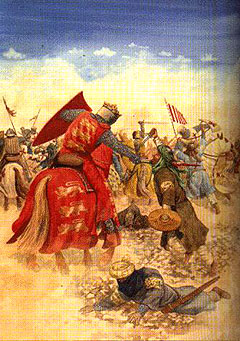
The lesson of the history that unfolded from Urban’s speech is that no war is holy. God doesn’t take sides in human conflicts. Corruption and crime occur on both sides of wars. But charismatic leaders can still whip up the frenzy of crowds with exaggerations and untruths.
As dusty and dry as is the history of the Middle Ages, it is filled with lessons that we forget at our own peril and the peril of generations yet unborn.
Copyright © 2012 by Ted Huffman. I wrote this. If you want to copy it, please ask for permission. There is a contact me button at the bottom of this page. If you want to share my blog a friend, please direct your friend to my web site.
50 years of stones
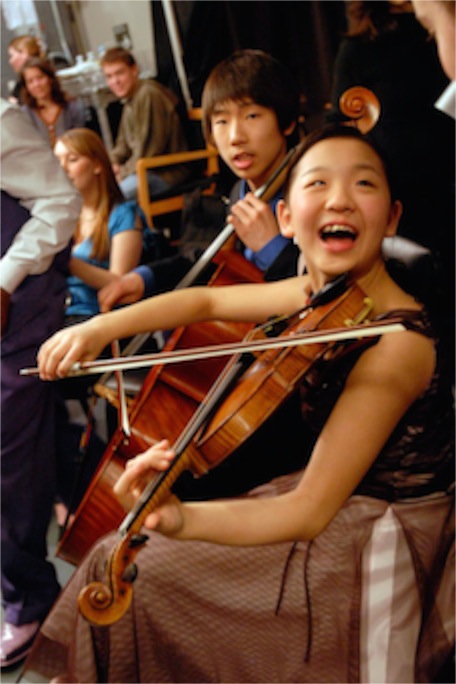
I’ve always loved music, and I can play a little, but lack the talent and discipline to become an artist. My role has been to support and promote artists through education, fund raising and organization.
My fellow board members at the Black Hills Chamber Music Society probably know nothing of my brief rock band phase. When I was in high school, I briefly imagined what the life of a stage musician might be. I played the guitar and I learned some of the chord progressions of music that was popular at the time. I kept trying to organize groups of other students into various bands. Mostly I invested a lot of energy in hauling around my brother’s drum sets. It is likely that he was always a better musician than I. He was also more interested in the social side of the rock band lifestyle.
I went on to college, where I played in the band and from there to seminary and into my career in the church. I have participated in several brass quartets and quintets over the years and still play my trumpet from time to time. I play the guitar and piano mostly for my own personal entertainment these days. The closest that I ever got to the stage of a rock band was that music that I did with youth groups over the years. I own two guitars, one of which I have had since high school. I joke that these days when I attend youth rallies or camps I am almost always the oldest one present. And my guitar is the second oldest.

There is another concert in London scheduled for Thursday, followed by one in Brooklyn, New York and two in Newark, New Jersey. It is the 50th Anniversary Tour of the Rolling Stones. If that doesn’t make you feel just a little bit old, you probably weren’t around when the band was formed or you thought that the Stones were “old school” when you were a teenager.
I can’t quite get my mind wrapped around a group of sixty- and seventy-somethings cranking out the rock and roll. The audiences, however love it. Music critic Neil McCormick said the music sounded as good as it did when he first started listening to the band in the early 1980’s. With all due respect to Mr. McCormick, the band had been cranking out albums for a couple of decades when he finally discovered the Stones.

I’ve never been a big fan of the Rolling Stones. I am not planning a trip to New York or New Jersey to see the band, though I do admire the dedication of the fan that made a trip from Australia to be at last night’s concert in London. I do need to say, however, that there is more to great music than just the things I prefer. There is more to classical music than the things I like.
The Rolling Stones are here to stay. Rock on!
Copyright © 2012 by Ted Huffman. I wrote this. If you want to copy it, please ask for permission. There is a contact me button at the bottom of this page. If you want to share my blog a friend, please direct your friend to my web site.
The Reign of Christ
The celebration presents some unique theological challenges. But first a bit of background is in order. Christianity began its journey under the domination of the Roman Empire. It eventually became mainstream within the empire, but in its early years it was considered to be an illegal religion and practitioners of that faith were persecuted and executed for their beliefs. Jesus himself was very countercultural and his crucifixion was done under the authority of the Roman government. In the face of this persecution, the early church began to formulate a simple theological declaration. Kings are not gods. The one true God is not embodied by the authority of human governments. There was a parallel construction that is even more challenging for contemporary Christians: patriotism is not the same thing as faith. Loyalty to a human government is different from obeying the commandment to love God with all of one’s heart, soul, mind and strength. When forced to choose between government and God, the Christian was called to respond to a higher authority.

But we are always handed texts from the Revelation of John for this Sunday. And it is a pastor’s obligation to attempt to make connections between the sacred texts and the everyday lives of the members of the congregations that we serve.
It is a perilous task, in my opinion. Jesus of Nazareth throughout his life before his crucifixion was not the king of messiah that many expected. He did not foment revolution against Roman authority. He didn’t play power politics. He didn’t advocate rule by strength or fear or intimidation. He seemed little concerned with taxation and other functions of government. He told his followers that whoever wants to be greatest must be the least of all and the servant of all. Then he demonstrated his words with a life of service, including washing the feet of his disciples. To equate the kind of leadership Jesus revealed with the way human governments work is a fallacy. But the language we have to speak of Christ is the language of humans.
In the English language, this is exacerbated by the fact that English translations of scriptures came about under the authority of a monarchy. The King James Version of the Bible uses the language of the English monarchy to speak of the authority of heaven. The four Hebrew letters of God’s name are consistently translated “Lord” by the KJV. The very name “Christ the King” uses the title of the English monarch.
The Congregational Church, forged in the time of the American Revolution from England, didn’t practice anything “the king.” Christ the King Sunday was not a part of the traditions of our corner of the church until it was recovered in relatively recent decades by those wanting to made a deeper connection to historic liturgy and the spiritual practices of the wider church.

Today, as has been the case for many years, I include in my preparations for the task of preaching a poem. I’ll conclude this blog with its thoughts.
"God's True Cloak" by Rainer Maria Rilke
translation by Joanna Macy + Anita Barrows
We must not portray you in king's robes, you drifting mist that brought forth the morning.
Once again from the old paintboxes we take the same gold for scepter and crown that has disguised you through the ages.
Piously we produce our images of you till they stand around you like a thousand walls. And when our hearts would simply open, our fervant hands hide you.
Book of Hours, I 4
All except the concluding poem is copyright © 2012 by Ted Huffman. I wrote this. If you want to copy it, please ask for permission. There is a contact me button at the bottom of this page. If you want to share my blog a friend, please direct your friend to my web site.
A good day for good work
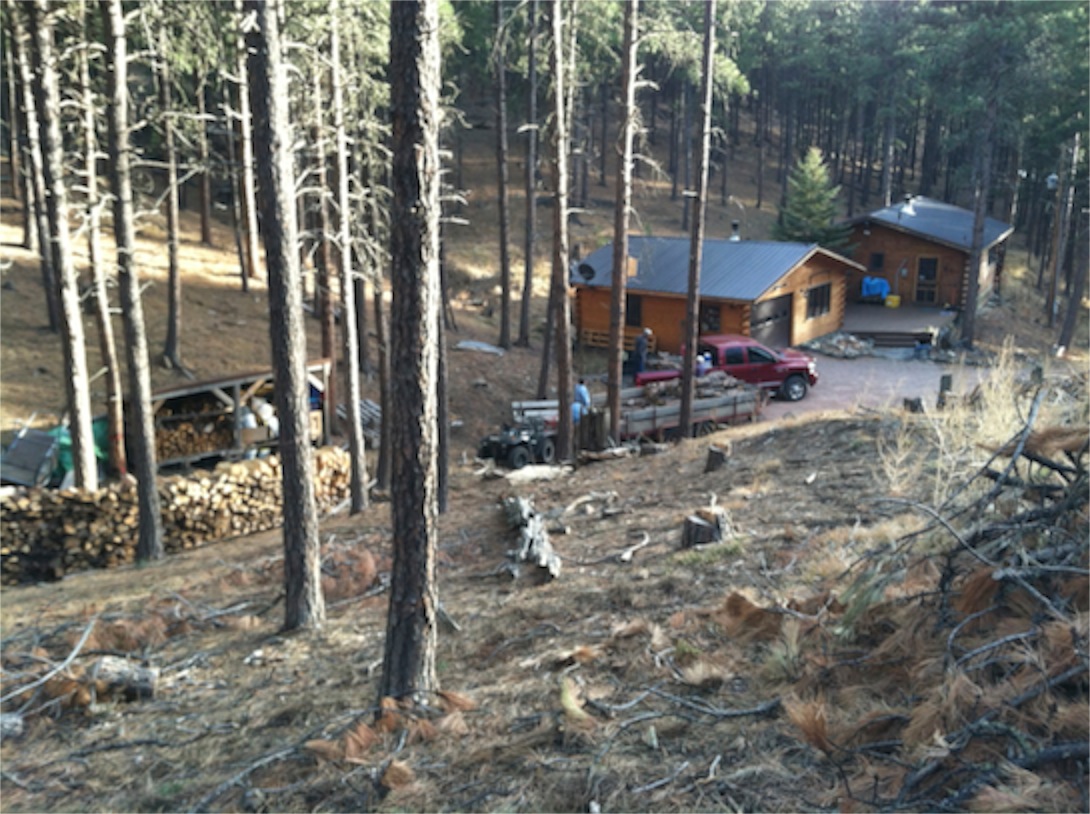
The infestation of pine bark beetles is affecting forests all over the western United States and Canada. Our little forest island, the Black Hills, is filled with areas of dead trees and the infestation is far from over. The hills are a maze of private and government owned land. The State of South Dakota, the National Forest Service, the National Park Service and other agencies control parts of the land. There is a mosaic of privately held land scattered throughout the hills. The result is that the response to the beetle infestation is a bit inconsistent. In general, wilderness areas are left untouched, allowing the infestation to run its course. There are a lot of dead and dying trees in these areas and they are especially vulnerable to fires. While fire is a part of the natural cycles of the forest, the combination of previous fire-fighting efforts with particularly dense forestation results in high fuel loads. When fires get going, they can be really devastating.
The National Forest Service has instituted tree-cutting programs to remove bug-killed trees in parts of the land it manages, but funding has been short of a comprehensive program. The National Park Service has smaller amounts of land and has been able to remove a larger number of bug trees before the bugs fly each summer. The State of South Dakota has also instituted aggressive tree-cutting programs, but funds are limited.
In the midst of all of these programs and agencies, private landowners are proceeding with the best information they can find. Trained foresters are available to walk the land and mark the trees. While trees can be sprayed with insecticides to prevent infestation, once the beetles are in a tree, the tree is almost always killed. Given the cost and potential risks associated with pesticides, the plan followed by most landowners is to cut the trees as quickly as possible and then to cut the logs into chunks. Foresters recommend pieces of 18 inches or shorter. If the wood dries quickly enough the beetles will die before they reach the stage where they fly to infest other trees.
The sound of chainsaws rings through the hills as people work to try to slow the rate of infestation. It is hard work. The land has plenty of steep hills and chainsaws are heavy and dangerous.
The Woodchuck Society is a grassroots effort in our church about which I have blogged many times. We take donated firewood, split it and deliver it to partners on neighboring reservations for use as fuel to heat homes and churches. The project started very small and has grown to annual deliveries of about 50 cords of wood. We are currently working on developing a third distribution site because we are receiving more and more wood each year. Recent mild winters have resulted in a slight decrease in demand in some areas while the woodpile in the church yard continues to grow.
We also are helping our neighbors who have lots of firewood on their land and who want to remove as much as possible to decrease fuel loads and reduce fire danger. We have to be careful with our handling of the wood, especially long logs, because our church is located below a beautiful forested slope. We don’t want to make the mistake of introducing pine bark beetles to our neighborhood.
There is no risk of an infestation in some of the reservation communities we serve. With no pine trees, the beetles can’t do their work of destruction. So we have hauled long logs directly to our partners and our Eagle Butte partners are cutting and splitting wood on site.
The beautiful weather has allowed us a few days out in the hills to collect the wood. Yesterday was a great opportunity to haul a load of logs to the woodlot. We were collecting from the land of members of our congregation and they helped us load, so there were seven of us who loaded the church’s large trailer and two pickup trucks with wood. The terrain is steep and some of the logs were quite a ways from the trucks so a four-wheeler and a small trailer were used to haul loads to the big trailer and pickups. There were some places where we could roll the logs down the hill from were the trees were cut.
It is good work for a pastor whose everyday routine is a bit too sedentary. It is really good for me to get outside and do some physical work. Rolling logs down a hillside and loading them into the truck burns off a few calories, stretches the muscles and improves circulation. While there are plenty of wonderful places in this world, the setting for our work is a great place to be outdoors. The landowners chose their place because of its beauty. And they share that beauty generously with their guests.
So I don’t have much to report of my day after Thanksgiving except that it provided good work with good friends in a beautiful location. And that is enough. It is, in fact more than enough. To be able to work in the hills assumes that I have enough food and that I have a way of earning my food that gives me leisure time. That isn’t true for all of the people in our community, let alone the world. There were plenty of people who couldn’t afford to take a day off from work yesterday. They’d love to have time to volunteer, but the struggle to survive consumes almost all of their waking hours. It takes more than one full-time job per adult to sustain a family at minimum wage.
I can never forget that living in the beautiful location where we have our home is a luxury that not everyone has. The increasing urbanization of the world’s populations leaves the luxury of living in a place with lots of open space to a small number of us. We are blessed. And it is good for us to remember that from time to time.
Copyright © 2012 by Ted Huffman. I wrote this. If you want to copy it, please ask for permission. There is a contact me button at the bottom of this page. If you want to share my blog a friend, please direct your friend to my web site.
Thanksgiving is more than one day

I have no plans to go shopping today. I don’t need anything and I doubt that there are any bargains out there that I can’t live without. I’ll leave the crowds and the frenzy to others. I’ve a ceiling to paint and I may join the Woodchucks picking up some donated firewood in the afternoon. It is a good day to get some exercise after a wonderful Thanksgiving dinner yesterday. I also have Alice Munro’s new collection of short stories and a novel by Adam Foulds that are sitting unread next to my chair in the basement. I won’t be getting bored.
I understand that retail merchants have to make a lot of sales at the end of the year in order to make the profits for which they have been working all year long. I understand that people are genuinely generous and want to have gifts to give to family and friends. But I have never discovered holidays to be defined by the things we purchase and I don’t really enjoy standing in line.
For me, the mood of Thanksgiving is quite different from the craziness reported in the papers. I have been so abundantly blessed in this life. I had wonderful parents and a loving home. I have sisters and brothers. I have been blessed with a wonderful marriage, two children and a grandson. I have a comfortable home and a room full of books. I have meaningful work and a church that really cares about serving others. And my life has been filled with beautiful sunrises and sunsets, gorgeous vistas of hills and mountains, travel to exciting locations and the joy of nature in my own backyard. We have deer and turkeys that visit us every day. The sky is filled with birds and our home is filled with food. I have never tasted hunger or wondered how I would feed my children. I have never feared the knock of the police on my door or had my life restricted by an authoritarian government.
With all of the blessings that I count at Thanksgiving, I see no need to want more. Going out and buying more things seems to be just the opposite of the mood of gratitude I feel for the things I do have.
There will be presents for my loved ones at Christmas. I’ve already made several small purchases and I will continue to do so over the next few weeks. I start to think about Christmas as Advent begins and the weeks of preparation are sufficient to slip into a shop or two and make an online purchase now and again. Pretty soon we have all sorts of things to offer as gifts to others.
The shopping craziness seems to be invading the holiday for some people. Some stores started their “Black Friday” sales on Thursday. Some people stay up late or get up very early to be first in line for special sales at area stores. It doesn’t matter to me what the customers do as long as they don’t injure one another, but I feel sorry for the people who work in the stores. For every store that is open at Thanksgiving, there are families who can’t spend a relaxing day eating a meal together, telling stores, and offering thanks to God for the blessings of this life.
Yesterday I baked some rolls and made a casserole to share and we headed to our friends’ place for a leisurely dinner and an afternoon of visiting and catching up. We had time to enjoy our dinner. We had time to enjoy each other. We were able to connect by Skype to our family members in distant locations. Food, friends and family are what the holiday is about for me. It makes me sad to think that there are those whose days were rushed by needing to go to work.
As I am writing, it is a little before 4:30 a.m. That means it is 3:30 a.m. in Oregon where my niece lives. A few minutes ago she posted on Facebook: “What happens when you get to work 40 minutes early? You sit outside the store with all the anxious shoppers answering all their burning questions.” I think that her store normally opens at 10 a.m. and is opening at 4:00 a.m. today. I know that my niece enjoys some of the excitement and frenzy of Black Friday and now that she works in retail, she is one of the clerks that will spend the weekend working long hours trying to keep the store in order for the next wave of customers. But I can remember when she was a little girl who loved to sleep in late in the mornings and I am aware of how much things have changed for her.
In the life of a pastor, there simply aren’t many weekends “off.” We struggle with the concept of Sabbath as surely as do our parishioners. When you only take one day off each week, there isn’t anything that feels like a weekend. But the arrangement of services and other church activities means that we almost always have three days in a row with very little work at Thanksgiving. I like to say that Thanksgiving is the only 3-day weekend that church employees ever get. That isn’t quite true, but Thanksgiving is usually a very relaxing time for us. In my dream world, everyone gets the weekend off. I know that wouldn’t work. We need employees to work in hospitals and care centers and we need firefighters and police to protect us, but we’d probably need fewer of those services if everyone stayed home with family and friends and didn’t need to rush off to the shops.
There are just too many things in my life for which I am grateful for Thanksgiving to be over in a single day. Even a season of gratitude would be insufficient. With all of the blessings that surround me, prayers of thanksgiving every day seem to be in order.
Copyright © 2012 by Ted Huffman. I wrote this. If you want to copy it, please ask for permission. There is a contact me button at the bottom of this page. If you want to share my blog a friend, please direct your friend to my web site.
Development and Growth
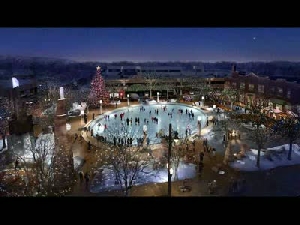
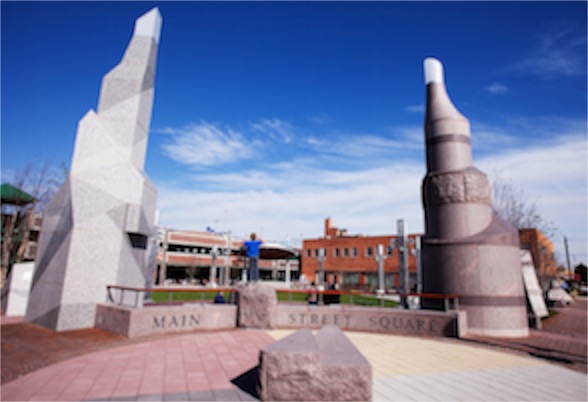
Still, I have on occasion grumbled about the expense. And I have wondered aloud whether or not we really need an outdoor ice-skating venue with artificial cooling to keep the ice smooth even when it is too warm outside for ice to form. Yesterday delivered an answer to my questions. I’m not sure whether or not the ice rink is open for skating, but when I drove by on my way back to the office from the post office yesterday morning, the ice looked perfect and inviting. The colored holiday lights are up and the place is ready for this weekend’s night lights parade. A few minutes later, I was south-bound on Mount Rushmore Road and drove by Wilson Park where there were a dozen ducks swimming in the shallow water where the Wilson Park Ice Rink would be if it had been cold enough to freeze the water. Maybe artificial ice is nice on some days in Rapid City.
I often would take a more conservative approach to development than those who are really successful at such ventures. Risk is part of the formula. If everything were a sure bet, then profits would be assured, but likely much more modest.
That balance of how far to push is always part of the ministry as well. How much do we risk when we develop budgets for our congregation? How boldly dare we dream when developing or improving buildings? How much investment is required to produce growth? How much growth is desirable? There are a thousand questions that come to mind.
We are in the process of making a comprehensive study in advance of a proposed capital funds drive to make a major investment in our building. I’ve been through a similar process in the congregation we served in Idaho, but the numbers are much bigger with this project. They may end up being the biggest numbers of my career. One of the ways that I am dealing with the various bids as they cross my computer screen is to say to myself, “We don’t need to do it all.”
But if Main Street Square needs refrigeration to make ice for skating, it could be argued that a congregation needs air conditioning to keep the building full during South Dakota summers. While I can see the argument for more insulation and a new roof, there are other parts of the proposal that seem to me to be extravagant. There are also other things that I understand that we need, but come with prices that I don’t understand. Parking lot repairs come up pretty high on my list of expenses that exceed my expectations. After all after spending tens of thousands of dollars you have exactly what you had before: a parking lot. OK the new one doesn’t have cracks and the striping is bold and clear. But that is about the only difference. Still, I understand that spending a little now prevents the need to spend a lot later, even if the “little” doesn’t seem to me to be little at all.
Our process still has lots of room for input from the congregation. I know that we will need to prioritize. I know that we will not be able to afford everything on our wish list. I know that there are difficult decisions ahead for a complex congregation where we don’t always agree. I’m not afraid of the process. But I hope that I can achieve just the right balance between faith and fear. I know that the Bible is very clear that we should not be afraid. But I don’t see anywhere in scripture that says we should take unnecessary risks with the generosity of Christ’s people, either.
The good news is that God has given us the gift of articulate voices that are on both sides of my vision. There are those who believe that we should do minimum maintenance only. There are also those who believe that we should be investing in creating a church of the future that will serve for decades into the future. And, likely, there are plenty of folks who come down somewhere between the extremes. What ever we choose, we are all in this together. The fund-raising will require the participation of everyone. The investment we are called to make is in the future of the congregation. The payoff on our investment may well be beyond the span of our lives.
As is true with other moments of discerning God’s call, I have come to rely on the congregation. The wisdom of the community exceeds the wisdom of any individual. My opinion needs to be given clearly, but I also need to be willing to submit to the wisdom of the congregation. This project isn’t about what I want, but rather about what is best for the future of the congregation.
Besides, there are many ways to find joy. After all, I find clear smooth ice for skating and ducks on a pond in the park both to be charming features of our city.
Copyright © 2012 by Ted Huffman. I wrote this. If you want to copy it, please ask for permission. There is a contact me button at the bottom of this page. If you want to share my blog a friend, please direct your friend to my web site.
Communicatations

The purpose of that convoluted paragraph is to say that not all the members of our church know each other’s names as we approach 600 members. They recognize each other, but they don’t really know each other. There are a wide variety of interests and passions in our congregation. So it is a challenge to simply get all of the activities and events out before the congregation in a way that they can make connections and form community.

So in our church we need to be content to know part of what is going on. No one knows everything that is going on. The office works hard to organize and track events and activities, but conflicts do arise. Sometimes we have to improvise and move a location at the last minute. Sometimes people make assumptions about who can participate only to be disappointed. But we try to keep the lines of communication open. Each month when our Communications Roundtable meets we discover mistakes that we have made and plan new ways to communicate.
Communication with the wider community is an equally daunting challenge. We are one of more than a hundred and twenty church and parachurch organizations in our community. The newspaper has a part-time religion editor who covers some church events and we issue regular press releases about our activities. Getting coverage on radio are pretty much “hit and miss” occasions. Once in a while we will do something that catches the eyes of a camera crew or makes a news story, but it often seems random to us when we are noticed and when we are not. If we make the television news, it is usually a slow news day and the crews at the station are scrambling to fill airtime.
Many of our internal communications are also ways of communicating with the wider community. The religion editor at the paper subscribes to our electronic newsletter. Often that is how stories make it from our church to the newspaper. Our web site is for our members and for those who are searching for a congregation. We have both a public Facebook site and a smaller Facebook group.
The process of keeping up with communications is always a challenge and something that we do imperfectly. But communication is our primary business. We have good news to tell and we are continually trying to discover new ways to tell our story.
And when a member of our board says, “I can’t keep track of what is going on around here!” I take it as a good sign of a healthy congregation.
Copyright © 2012 by Ted Huffman. I wrote this. If you want to copy it, please ask for permission. There is a contact me button at the bottom of this page. If you want to share my blog a friend, please direct your friend to my web site.
Searching for original ideas
The world is changing. The use of computers and the Internet by my students is universal. The papers I read contain all sorts of information that has been gleaned from the Internet, often without much discretion about what is factual and what is not. Worse, in my opinion, is that there is almost no care taken in discovering original sources. A student will cite as a reference a source that simply didn’t credit the source of its ideas. Plagiarism is redefined in the age of the Internet. Students use ideas without having a clue of their sources. It is sad to me that serious students lack the ability to discern the difference between an idea that has been part of our tradition for centuries and those that are genuinely new. Ancient disputes and controversies re-emerge in the writings of students without the students knowing that these arguments have played a role in the formation of the church for generations.
Part of the challenge for teachers is that of imparting critical thinking skills. Students can learn to distinguish between academic research and opinion. They can obtain skills for weighing the value of arguments and tools of logic for making judgments.
The larger challenge is dealing with the sheer volume of information that is available. In a pre-computer world, we used to go to libraries and review all of the relevant literature at the beginning of a research project. The literature review would tell us roughly what had already been written on our chosen topic and how the ideas had been treated by others. Our search was limited by the resources of the library. We didn’t have access to all of the documents that existed. We had the trusted sources that were employed by the library. By the time I got to graduate school, it was common for me to conduct research in multiple libraries, knowing the strengths and weaknesses of various collections. We chose our seminary in part on the group of different schools who had clustered in one location and formed agreements that allowed the easy transfer of information and sharing of learning between multiple schools.
These days I have access to the materials of universities around the world. I don’t have to travel to a specific address to check out the collections of major libraries. Virtually no journal research is done by obtaining actual paper copies of published journals. We read the articles on the screens of our computers after accessing them through the digital databases of university subscription services.
So it shouldn’t surprise me that students are confused about which sources to trust and which to ignore. It shouldn’t surprise me that students think that they have done their research and produce writing that is at the same time less than original and far from well researched.
The volume of information available makes it virtually impossible to know the origins of an idea. There are a few software applications that assist teachers in finding plagiarized ideas, but they are not very valuable for the papers that I read. My students believe that they are doing research when they find ideas that are new to them. They are usually not dishonest about crediting the sources of their materials. But the sources they cite are often far less ethical in crediting their sources than the students.
With the volume of information available, how does one discern whether one is being original, or merely repeating an idea that has been in circulation for a long time? Paul Rubens, in a piece written for BBC News, wrote about intellectual property and computer development. His article says that part of the reason that computer companies are constantly engaged in patent lawsuits is that it is less expensive to engage in patent lawsuits than to do the original patent research. With nearly 250,000 active patents relevant to mobile computing devices and an average of 20 claims of originality in each patent yields something like 5 million restrictions on intellectual property. There aren’t enough patent attorneys in the world to research every possible patent infringement in a new product. And if there were enough attorneys, there isn’t enough money, even in the super successful high tech firms, to pay for the research.
So they produce products, purchase as many patents as they can afford, and prepare to defend themselves in court. Sometimes they win and sometimes they lose. When they lose the cost seems high. Apple was recently ordered to pay $368 million to Connecticut-based VirnetX. Those settlements, however, are considered to be a part of routine business for the manufacturers of computers.
On a much smaller scale, my students engage in similar maneuvers. Overwhelmed by the huge volume of potential articles on any given topic, they read a few, make a few educated guesses on what the others might contain, then sit down and write without knowing that they have not exhausted the subject. The ease of internet publication has made everyone an instant expert.
Peer-reviewed articles still exist. There are sources that can be trusted. But teaching basic research methods to my students would take more time that I am allotted for the content area I am expected to teach.
So I will struggle with the papers as I complete my task. I will, as usual, grade on a bit of a curve, comparing the performance of the students to each other and setting aside my general disappointment in the entire stack of papers. I will enable the students to go on to the next courses and complete their programs believing that they will continue to learn and mature with time and experience.
And I keep reading carefully in hopes that one day I will discover a truly new idea in the midst of all of the clutter. The task gets more difficult each day. After all, I add 1,000 words of clutter each day with my morning blog.
Copyright © 2012 by Ted Huffman. I wrote this. If you want to copy it, please ask for permission. There is a contact me button at the bottom of this page. If you want to share my blog a friend, please direct your friend to my web site.
What we remember

Of course we don’t need absolute historical accuracy to have stories worth telling. We like the stories of the Pilgrims celebrating their first harvest and are likely to repeat them again and again. And we are unlikely to tell the complete story. In fact we probably don’t know the whole truth. Given the religious convictions of the Pilgrims, for example, it is likely that part of the preparation for the feast of Thanksgiving was a period of fasting. So perhaps we ought to begin our preparations for our festival this Thursday not by shopping, but by fasting. It might be healthier than diving into a spectacle of food on a full stomach.
The day of celebration also is unclear. Our modern celebration of Thanksgiving on the fourth Thursday of November was established on December 26, 1941 by federal legislation. President Franklin D. Roosevelt had moved the date earlier in 1939 in an attempt to stimulate the economy. The uproar that followed prompted the legislation that President Roosevelt signed.
President Lincoln is credited with establishing the holiday as a nation-wide observance. He issued a proclamation in 1863 calling for the final Thursday in November to be observed as a day of Thanksgiving in an attempt to pull the fractured Union together. Because the Southern stated did not recognize Lincoln’s authority, the concept of a “nationwide” Thanksgiving did not really take effect until the 1870’s after the war.
But there is a November date from the Lincoln presidency that we do remember. On November 19, 1863, Lincoln delivered the Gettysburg Address. In the speech, Lincoln noted: “the world will little note, nor long remember what we say here.” Lincoln was wrong. The world did note what he said. Senator Charles Sumner commented a couple of years later: “The world noted at once what he said, and will never cease to remember it. The battle itself was less important than the speech.”
I memorize the speech when I was a child.
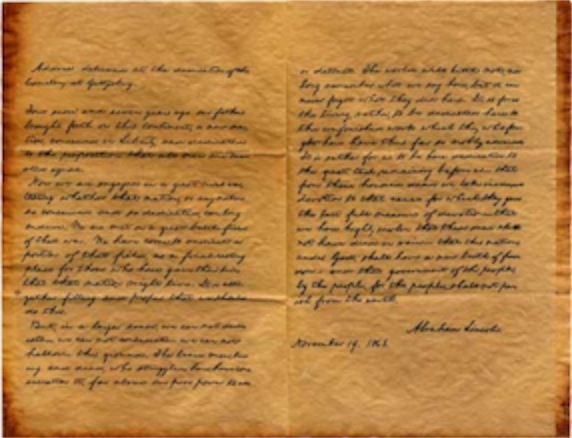
“Now we are engaged in a great civil war, testing whether that nation, or any nation so conceived and so dedicated, can long endure. We are met on a great battle-field of that war. We have come to dedicate a portion of that field, as a final resting place for those who here gave their lives that that nation might live. It is altogether fitting and proper that we should do this.
“But, in a larger sense, we can not dedicate -- we can not consecrate -- we can not hallow -- this ground. The brave men, living and dead, who struggled here, have consecrated it, far above our poor power to add or detract. The world will little note, nor long remember what we say here, but it can never forget what they did here. It is for us the living, rather, to be dedicated here to the unfinished work which they who fought here have thus far so nobly advanced. It is rather for us to be here dedicated to the great task remaining before us -- that from these honored dead we take increased devotion to that cause for which they gave the last full measure of devotion -- that we here highly resolve that these dead shall not have died in vain -- that this nation, under God, shall have a new birth of freedom -- and that government of the people, by the people, for the people, shall not perish from the earth.”
It was recited at a wide variety of public occasions and celebrations throughout my childhood. I know very little of the dynamics of the actual battle fought at Gettysburg. But I know the words that President Lincoln said there when the national cemetery was dedicated on this day in 1863.
In a similar way, it is nearly impossible for us to predict what of our lives will be remembered by future generations. Will they remember the over-indulgence of our feast tables? I would prefer for them to remember our generosity in sharing with our neighbors. Will they remember our obsession with technologies that rapidly become dated and are replaced by more gadgets? I would prefer for them to remember our use of technologies for worldwide conversation. Will they remember our denial and inaction in the face of global climate change? I would prefer for them to note that ours was the generation that made the commitment to changing our behavior for the sake of future generations.
In each generation we are given the possibility of making history. We add to the long line of history that preceded our time. Our time, however, is short and we don’t get to choose which stories will be remembered. That will be left to those who follow us.
It does make me want to be a bit more accurate in the way that I tell the stories of my forbears.
Copyright © 2012 by Ted Huffman. I wrote this. If you want to copy it, please ask for permission. There is a contact me button at the bottom of this page. If you want to share my blog a friend, please direct your friend to my web site.
Working together
60 turkeys is a lot of weight – nearly 1,000 pounds. One of the members of our congregation provided his pickup so we loaded chainsaws, a wood splitter and all of the turkeys and there was room for five of us to ride comfortably in the cab. It takes 2 ½ hours to get to Eagle Butte, but we were there before noon and Norman was waiting for us when we arrived. Transferring the turkeys to Norman’s pickup took just a few minutes.
Last spring we hauled logs to Norman’s place for our Woodchuck project. We had an excess of wood from trees that had been killed by bark beetles and we wanted to get the beetle logs out of the church yard before it was time for the beetles to fly. We didn’t want to share the beetles with the trees in our neighborhood. There are no pine trees anywhere near Norman’s place above the Moreau River northeast of Eagle Butte. Norman worked out a plan to get a splitter from the tribe and they have been working throughout the summer and early fall splitting most of the wood that we brought, but their chainsaw isn’t always reliable, and cutting up the big logs was a challenge.
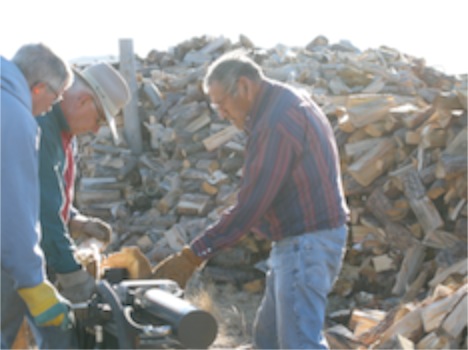
Of course, we stopped our work at noon for a lunch. It never ceases to amaze me how much food appears when we get together for a meal. I just brought a few things from home, as did others and then some of our church members sent along cookies and treats for the trip and soon a feast was spread on the tailgate of the pickup.
When we started our firewood project is was the convergence of people who had excess wood that they needed to get rid of and people who needed wood to heat their homes. By cutting and splitting together, we added in the element of working together. We envisioned the program would be a mission – an outreach of our congregation to others who had need. What we might not have seen as clearly in the beginning was how it would become a bridge of friendship. Because we rely on our partners who live on the reservations to distribute the firewood, they invest as much work as we do and delivery days become an opportunity to work shoulder to shoulder with others who are investing their lives in making things better for their neighbors. The generosity and graciousness of our hosts always delights and amazes us.
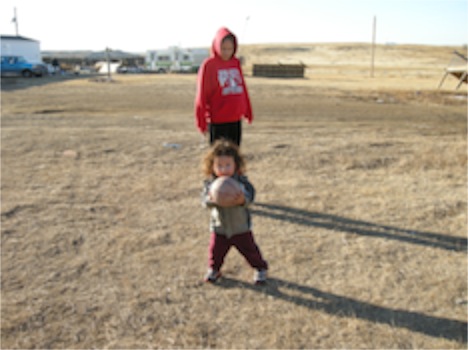
It began as a vision of us doing something for others. It has evolved into a project of working together with others to serve still more people.
We have a wonderful program in the South Dakota Conference that took its cue from a project of our church in its national setting. Sacred Conversations provides opportunities to gather folk from across South Dakota to talk about race and racism in our state. It also provides opportunities for us to have an annual retreat with the pastors who serve our Native American congregations in the Dakota Association. I am grateful for the sacred conversations. But I am also aware that there are some very important connections that are not based in words. We have a heritage of talking and we love to get together to talk.
Sometimes, however, it takes more than talk to build relationships. For us, the hands-on work of cutting and splitting firewood to heat homes and churches builds relationships that might not have grown from more talk. I think that conversations are essential, but relationships that are only talk are insufficient to build a new future together. I am grateful for our shared mission.
We found the same thing in our partnership with our sister church in Costa Rica. Working together to serve the children of Los Guido gives us a common purpose. We come to understand each other best when we combine our efforts in the common work of serving others.
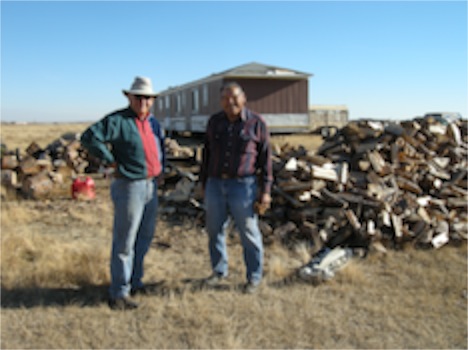
And a few of us are just gently stiff enough as we rise this morning to remember how good God’s gift of work really is.
Copyright © 2012 by Ted Huffman. I wrote this. If you want to copy it, please ask for permission. There is a contact me button at the bottom of this page. If you want to share my blog a friend, please direct your friend to my web site.
I don't understand the war
So it probably doesn’t surprise anyone that I can’t figure out the latest round of violence in the Middle East. But I REALLY don’t understand the events in Israel and Palestine in the past few days. I don’t get it.


If you kill enough children, you virtually guarantee another generation of militants with nothing to lose. If you maim enough innocents, you hand your neighbors reasons to continue to send arms into your backyard. Generations of military history has proved that while you can win wars with weapons, governing with weapons rarely succeeds.
But they continue to let the weapons fly. And the children continue to die. And the hatred and terror become so deeply ingrained that neither sides can recognize the humanity of their opponents.
I don’t understand it, but I grieve the pain and suffering. I don’t understand it and I keep asking, “Why?”
After the horrors of the 20th century is it wrong to believe that Israel has a right to its own nation and the means to defend its citizens from attack? Is it wrong to condemn those voices that claim that Israel has no right to exist? Is it wrong to believe in the principles of democracy that are inherent in the government of Israel? Because I cannot see a solution for the Middle East that does not involve a free, strong, safe and democratic Israel.
But is it wrong for Palestinians to aspire to be able to feed their families and work without degradation? Is it wrong for them to resist the bulldozing of their homes to make way for Israeli expansionists? Is it wrong for them to oppose the building of a wall that separates them from their historic lands and their means of earning a living? Is it wrong for them to want health care and education for their families? Because I cannot see a future for the region that doesn’t defend the rights of the historic residents of the region to the pursuit of their lives and self governance for those who live beyond the borders of Israel as well as those who are citizens.

Jerusalem is the city whose name contains the word “Shalom.” It has been the vision of thousands of years of generations of our people that the city might be a place of peace. It was founded with the vision of peace and justice that would be an example for the entire world. Its very name speaks the aspirations of the whole of our history: “Peace!”
Yet still there is no peace in Jerusalem. Jesus is still weeping.
The rocket fell short of the city proper yesterday. But the air raid sirens rang throughout the city. Parents and children playing in the parks were uncertain whether it was the normal Sabbath siren at the beginning. They slowly came to the realization that the air raid sirens were screaming and they should take cover, but they were unclear about which way to go. The fear was palpable. There are plenty of frayed nerves and shaken people in Jerusalem this morning. That is the way that terror works. It spreads fear far beyond the range of its weapons.
This morning Jerusalem wakes to the reality of modern warfare. Innocents die. Civilians are at risk as surely as those who take up the uniform to fight. When war rages no one is safe.
Jesus is still weeping over Jerusalem.
Jesus is still weeping at the grief of those whose brothers have died.
Jesus is still weeping over the death of his friends.
And I don’t get it.
Jesus isn’t the only one weeping.
The photos accompanying this blog are by Mahmud Hams/REUTERS. The text is opyright © 2012 by Ted Huffman. I wrote this. If you want to copy it, please ask for permission. There is a contact me button at the bottom of this page. If you want to share my blog a friend, please direct your friend to my web site.
Dreaming of Trains

Sometime in the fall each year the Sears and Montgomery Ward catalogues came out. When we were kids, there was a fair amount of time invested in perusing the catalogues and wondering at the things that were on sale. It was our form on Internet shopping in the days before the Internet. There were two sections in each catalogue that always caught my attention. After a few days the catalogues would open to the correct pages. One of the sections was filled with bicycles. They had some amazing bicycles that simply weren’t stocked at the retail stores in town. We had two hardware stores and for a while we had a Sears catalogue store. Gambles and Coast to Coast had a few bicycles in stock, but they were the basic models. The catalogue had 10-speed European style racing bicycles, bikes with banana seats and high-rise handlebars. There was even a 5 speed bicycle with a t-handle shifter mounted on the bar.
In terms of sheer time spent, however, the section of the catalogue that warranted the largest slice of my attention was the section on model trains. There were two schools of thought on trains at that time. Lionel was probably the biggest vendor of model train sets. Their O gauge trains were amazing in their detail. They had locomotives with the paint jobs of the main lines that ran through our state: Northern Pacific, Great Northern, Milwaukee Road. They had the most amazing log car with a device that unloaded the logs as the car passed by a special section of track. They had remote switches and trestle supports that looked like they were made out of stone. You could get smoke fluid for the stacks of the locomotives and water towers and model depots to put alongside the track. There was just one drawback to the Lionel trains. Their system was based on three rails with the hot rail being the center rail. This made the trains very dependable. They worked well. But we didn’t have any rail lines in our area that had three rails. So I thought that the Lionel tracks looked fake.
There was another reason in addition to that for my loyalty to the American Flyer Model Railroad. American Flyer trains were a product of the A.C. Gilbert Company. A.C. Gilbert was the developer of what was (and remains) my all-time favorite building set: The Erector Set. Erector sets came with real steel beams, bolts and nuts, wrenches and screwdrivers. You could get motors and wheels and gears that really meshed and worked. In my mind, Erector sets and American Flyer trains made the perfect combination. We had a 4 x 8 train board in our room that was constantly filled with track, trains, and erector set constructions.
When our son chose Pacific University in Forest Grove, Oregon, for his undergraduate studies, I was delighted. One of the school’s famous alumnus was none other than Alfred Carlton Gilbert, the inventor of the Erector Set and the owner of the company that produced American Flyer Trains.
When our son was born it was all I could do to suppress the urge to buy a model railroad set for him way before he was old enough to enjoy it on his own. As the years went by, we did get into model railroading a bit. I built him a train board and we invested in a modest amount of HO gage track and running gear. Truth be told, I think I was into the train sets more than he. I suspect that he would name Lego building blocks as one of his favorite childhood toys.
Given my history, it would be fair to say that one of the high points of my day yesterday was receiving a photo taken by our daughter-in-law of our grandson playing with a small Brio Wooden train set. My first impulse upon seeing the picture was to try to find enough days off and enough cash to jump on an airplane and go spend some time with my grandson. My second impulse was to head to head to the Internet and start ordering additional Brio train sets to expand the basic circle of our grandson’s play.
Of course neither impulse is the right thing to do at the moment. We have Skype for nurturing our relationship with our grandson over the distance and we need to plan and coordinate our visits so that we nurture healthy relationships with all of our family. And our grandson doesn’t lack for toys. He doesn’t need to be overwhelmed with a grandfather’s obsession in order to enjoy a simple train set that is appropriate for his age and stage of development. Following my initial impulses isn’t the best way to wise decisions.
OK, if you can keep a secret, I did order an engineer’s cap, bandanna and train whistle to include in the Christmas package for our grandson this year. He loves hats. And he loves trains. I couldn’t resist.
The arrival of the picture of our grandson gave me the gift of 15 minutes of looking at train sets on the Internet last night. It reminded me of the days when I was a kid and the catalogues arrived from the various stores in time for Christmas shopping. Nostalgia is one of the indulgences I allow myself as I justify my re-definition of “middle aged” from 50’s to 60’s.
These days, I dread the arrival of catalogues in the mail. We get so many that they pile up before we can haul them to the recycling bin. Instead of one grand annual catalogue that lasts for a year, some vendors issue multiple catalogues each month. There are sales catalogues, and holiday catalogues and special event catalogues. One order placed on the Internet gives the catalogue shippers both your billing address and your shipping address. I once ordered a part for a boat I was building and I now receive high-end yachting and yacht racing catalogues at work and at home. I think the part I ordered was the only thing in those catalogues that I could afford. And when I am looking for those kinds of things, I don’t page through catalogues any more. I turn to the Internet.
But if I had a copy of the 1959 Montgomery Ward Catalogue in my hands these days, I bet I could waste a perfectly good hour looking at American Flyer trains.

Copyright © 2012 by Ted Huffman. I wrote this. If you want to copy it, please ask for permission. There is a contact me button at the bottom of this page. If you want to share my blog a friend, please direct your friend to my web site.
Facing the Cliff

The urban dictionary has some discussion about the exact age when a person is considered to be “over the hill.” One entry says, “meaning that you are 40yrs old, therefore you have reached the climax of your life time and your beginning to go ‘over the hill.’” I wonder if the urge to correct the grammar is part of being “over the hill.” Perhaps our generation used to many apostrophes with all of the contractions we use that there are none left for younger writers.
Another entry in the urban dictionary reads: “when you are 50-yrs-old and to old to live . . .” Apparently we have also unwittingly created a shortage of vowels. I, however, seem to still have enough to spell out “years” and make the distinction between “to” and “too.” But then I am over 50 years old.
Yet another entry reads: “In the rest of the world over the hill refers to someone over 50 or 50 but in Birkenhead your considered past it if you aren’t married with kids at 19.”
I’m not sure, exactly, why I read the urban dictionary, except for a general love of dictionaries. I remember when our children began to visit their friends at mealtime and discovered that not all families keep an unabridged dictionary at the dinner table for easy reference during mealtime discussions. Those kids have now grown up and established homes of their own and we’ve moved on to laptop computers for quick reference to a variety of dictionaries. I never could afford a printed copy of the Oxford English Dictionary, but the online version works well.
The OED, by the way, doesn’t attach an age to “over the hill,” stating: “informal old and past one’s prime.” It also cross references “as old as the hills” and “a hill of beans,” which I found reassuring since it seems possible that the “hill” that I am now “over” didn’t amount to much in the first place.
I was thinking of how we use words because the news sites that I read seem to have fallen in love with the phrase “fiscal cliff.” It has been a little while since I have visited Washington, DC, but my memory of the place is that it is pretty flat. There are a few gentle hills, but one has to use one’s imagination to think of any precipice in the city that is steep enough to cause injury except for the walls of buildings. The fiscal cliff, however, does seem to be of human origins and not a part of the natural world.

Of course I don’t really want my taxes to go up. And I don’t really want the US to enter into another recession. But I wonder if using the term “fiscal cliff” is really helpful in finding a solution.
If the urban dictionary can be noted for bad spelling and grammar, perhaps Washington DC could be noted for bad metaphors.

They can say what they want about fiscal cliffs, but the metaphor threatens to forget some real people I know who have already gone over the edge and dropped out of the sight of the politicians. That mortgage crisis a few years ago really did result in real people losing not only their homes, but with the homes their life’s savings. I know people who instead of thinking about retirement at age 60 are wondering how to find a job that will pay enough to make rent and groceries for the next decade so they can delay applying for Social Security enough to get their benefits up a bit. I’ve been in the home of folks living in a 25-year-old rented trailer house who have been paying social security all of their lives and watching the folks in the 6,000 square-foot-home up the road from them drive by in their Mercedes. They know how much the bail out of banks and insurance companies cost federal taxpayers. And they noticed who did and who did not lose their homes.
I know a widow who was stuck on the horns of a dilemma recently when a family member with an addiction stole the money she had set aside to renew her prescriptions the next day. Her “fiscal cliff” was only $300 tall, but it might as well have been a million since she could see no way to overcome the dilemma.
I had a conversation with a guy a couple of weeks ago who, on the advice of a doctor, rushed his wife to a hospital 200 miles from his home, arriving without enough money to fill the gas tank for the return trip. A one-day’s delay in his return might not just have cost him in lost wages. It might have cost him his job. Gas money isn’t a problem when you don’t have a car any more.
There are a lot of people in my circles for whom the fiscal cliff doesn’t appear to be looming at the transition between 2012 and 2013. It seems to be something they’ve already been over. And, for what it is worth, in most of the cases it didn’t feel like a cliff at all. It was a gradual decline. Two adults working at minimum wage in our town doesn’t raise a family above the poverty level. At least the kids can get a free breakfast on the days when school is in session. Salvation Army Thanksgiving boxes contain less than half the groceries they did a decade ago. The demand is just too high.
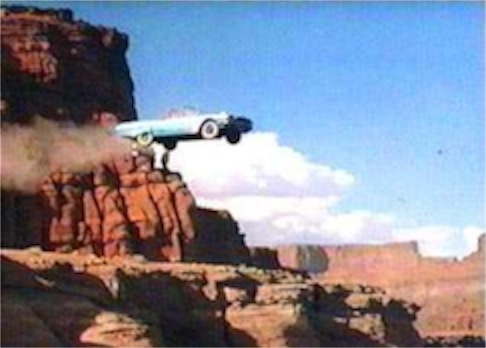
Copyright © 2012 by Ted Huffman. I wrote this. If you want to copy it, please ask for permission. There is a contact me button at the bottom of this page. If you want to share my blog a friend, please direct your friend to my web site.
On writing
I like Emily Dickinson in part because I like her story. She was, to say the least, an eccentric person. She was born into a successful family and after graduating from the Amherst Academy, she spend a short time at Mount Holyoke Female Seminary before returning to her family’s home where she lived a reclusive life. Most of her friendships were carried out by correspondence. She wrote nearly 1,800 poems, but fewer than a dozen were published in her lifetime. Only after her death, when her sister Lavinia discovered her poems, were they published. Then it took a while for her to become recognized as the poetic genius that she was. Her poems deal with many themes, but death and immortality play heavily in her work. The point is that she didn’t write because she was being published. She didn’t write because it brought her fame or wealth. She wrote because she had to write. She wrote because being a writer was her identity, not her job.
Of course, if you want to be an Emily Dickinson it doesn’t hurt to come from a wealthy family so that you don’t have to earn a living in order to sustain yourself.
The process of writing is, of course, a fascination for me. I write an essay each day for an audience of dozens. My blog hasn’t exactly “gone viral,” and I don’t expect it to. I publish my essays in this fashion for a couple of reasons. I don’t want to discount the fact that I do enjoy having some people read my essays. I enjoy the comments that I receive from readers. But I have no fantasies about what I write having broad-based popular appeal. I am content with a few readers. I write primarily as a spiritual discipline. It is a way of sorting out my thoughts and ideas. It is a way of chronicling my life. It is a way of leaving a sort of record of my intellectual processes behind. And it is a way of connecting with things beyond myself.
It is not uncommon for me to read the rules for essay and short story contests. I have even indulged in fantasies about winning such contests. However, I won’t be winning in part because I don’t enter. I don’t think that prizes are the reason that I write.
Today we celebrate the anniversary of the US publication of what was to become a very famous novel. Moby-Dick was first published in England in October of 1851, in three volumes titled “The Whale.” On November 14 of that year it was released in the United States under the title by which we know the novel, “Moby-Dick.” It was a commercial flop. Herman Melville was very successful with his first published book, “Typee” about his experiences in Polynesia. The sequel, “Omoo,” published in 1847 was also successful. Three more novels followed, with mixed reviews. “Moby-Dick,” his sixth novel didn’t sell well at all. His career floundered after that with novels, short stories and poetries, but failed to earn enough money to support Melville. He made his living as a customs inspector. By the end of his life in 1891, he was largely forgotten as a writer. His final novel, “Billy Bud” remained unpublished for 33 years after his death.
I’m not sure what dynamic caused literary scholars to “rediscover” Melville in the 1920’s, but Moby-Dick became popular during that decade and since has remained on the list of recommended books for high school students. Most Americans now know the name Herman Melville and associate him with the epic novel Moby-Dick. The fame escaped him during his lifetime. The millions of dollars that the book has earned never came to him.
I don’t think that the promise of wealth or fame make for particular good writing. Certainly there are gifted writers who have earned both with their craft. And some of the successful writers have produced works of lasting value that will be remembered long after the end of their lives. But much of what garners public attention in today’s market will be forgotten within in a few years.
Richard Bach wrote “Jonathan Livingston Seagull” in 1970. The book was a huge success. It was turned down by several publishers before Macmillan decided to take a risk on the 10,000 word book. The book broke all hardcover sales records. It sold more than a million copies in 1972 alone. It was turned into a movie. Bach wrote another book, “Illusions: The Adventures of a Reluctant Messiah” that was published in 1977. It didn’t sell well. He pretty much sunk into obscurity after the movie about his first book was produced. When he was seriously injured in an airplane accident in August of this year, the event scarcely made the news reports. The public is fickle. Fame is fleeting.
Almost no one knows that Bach’s first wife, Bette, who typed and edited most of his writings, wrote her own book, “Patterns,” about her life as a single mother and pilot. I can’t help but thinking that the divorce was a bad career move for Bach. It certainly looks like his wife’s editing was critical to his success as a writer.
But it is too early to judge any living author. It takes time, sometimes a century or more, for the lasting value of any work to emerge.
Who knows, in the randomness of how things are preserved on the internet, perhaps one of my blogs will be read by someone a decade or more from now. Someone might even comb through all of the words (more than the length of “Jonathan Livingston Seagull” every two weeks) and find a sentence or two that is meaningful and worth remembering.
In the meantime, I write because it is who I am and what I do. And if you’ve read this essay to this conclusion, you are a rare individual. Not many people do.
Copyright © 2012 by Ted Huffman. I wrote this. If you want to copy it, please ask for permission. There is a contact me button at the bottom of this page. If you want to share my blog a friend, please direct your friend to my web site.
People and Places
For 65 years our family has owned property in Big Timber. The house in town where we grew up has been sold. The buildings at the airport have been sold. The Big Timber Farm Supply has been sold. Houses once occupied by my brother and my Uncle Ted had been sold. The only property still in our family in our home town is our summer property. And that property is for sale.
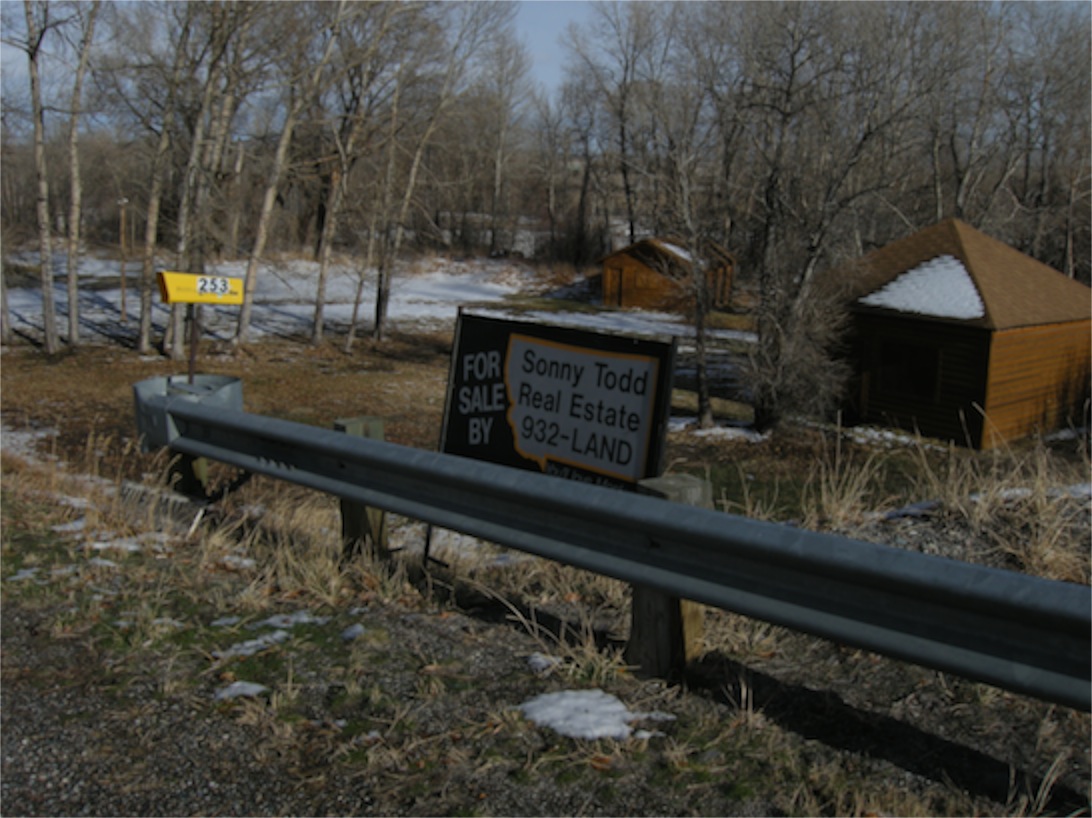
Selling the cabin is not something about which all of my sisters and brothers are in agreement. Since my parents had seven children, each of us owns one seventh of the property. Some think that we ought to keep the property. They reason that one-seventh of the proceeds isn’t enough to purchase property, so we go from owning real-estate to not owning real estate. They also feel that the property is a good investment that will grow in value over the long run.
But there are problems with join ownership. We have different expectations in terms of maintenance. We have different abilities to contribute to the costs of insurance, taxes and maintenance. The thought of having to obtain agreement from seven stakeholders for each decision isn’t particularly appealing.
It was about a year ago that we decided to put the property on the market. The place, however, is a unique property and we knew that it likely wouldn’t sell quickly. So while we wait for an offer, we have responsibilities. So I set of early yesterday morning to check out the place, blow out the water system and get everything winterized. It is a quick trip. I was on the road before 5 a.m., dodging two deer that were standing on the Interstate before I got to Sturgis.
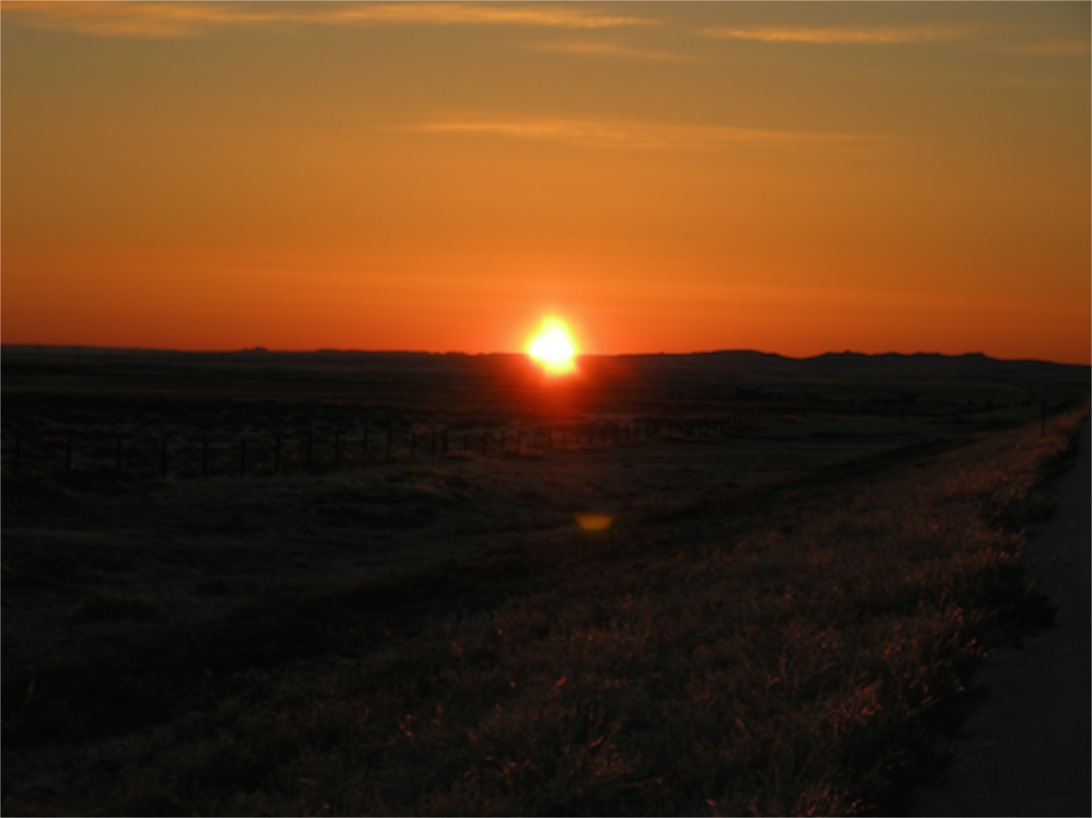
Sunrise was gorgeous behind me as I encountered ribbon ice that quickly turned into completely icy roads by Alzeda. Before Broadus, a truck has spun out trying to climb a hill and there was an officer slowing down traffic and issuing warnings. I proceeded without any trouble in my sure-footed Subaru, but was slowed significantly by the ice. Before I got to the Interstate at Crow Agency, I had passed three accidents, including one that looked very serious, where two cars had impacted head-on. There were officers and an ambulance at the scene. Once on the Interstate, where the road was good, I saw two more ambulances heading towards the icy section of highway. It wasn’t a good day for some drivers.
The ice slowed me by only about an hour and by 1 p.m. I was draining the hot water heater and blowing out water lines at the cabin. The work took a little over an hour and by 3 p.m. I was sipping coffee at my sister’s home 20 miles back towards our home. The combination of slippery roads and early sunset meant that I decided early on not to drive all the way home. I’m in Sheridan, Wyoming, this morning, having decided to come home via the Interstate. I’ll be back in the office in the afternoon tomorrow.
I have been thinking as I drive about the concept of home place. From early in our history, our people have weighed the life of being settled against the life of wandering. In one of our stories, God favors the offerings of the shepherd over those of the farmer. The story doesn’t explain the preference, only the tragic and violent reaction of the farmer. Our people find favor living as wanderers in the desert, but their existence is inspired by the promise of a land. When we came into possession of that land, we seemed to have a tendency toward corruption and injustice. The greatest of our kings tended towards excess. David couldn’t control his passions. Solomon tried to consolidate all of the wealth, power and knowledge only to see the injustices of our people mount until a time of defeat, destruction and exile. The prophets warned us, be we didn’t heed the warning.
The lesson of all of this is that we have had a strong and passionate belief that God is not contained in any single place. Ours, we say, is the God of all places. Theologians have said that God is best revealed in history not in place. Still, there are places that are sacred to our people. Jacob named the place where he wrestled with his conscience and an angel, “Peniel.” The mountain where Moses received the commandments, Horeb, has always held special meaning for us. Mount Nebo, from which Moses glimpsed the promised land before he died is said to be holy.
In the stories of my small family, there are places that have meaning for us. We tell the stories of Grandpa Walt being born in the soddy on the homestead near Minnewaukan, ND, near Spirit Lake, also known as Devil’s Lake. Most of us can still find the place where grandmother Eva spent the winter in the claim shack to prove up the homestead that became part of what today we call the River Ranch. There is a kind of nostalgia for me when I walk across the ramp at the airport in Big Timber. And I indulged in a few quiet moments to walk along the river after I locked up the cabin yesterday. Place is important to us.
But it is not our whole story. And as the time comes to leave one place and head out for another, we are reminded of the stories of Abram and Sarai and how our people have a long tradition of going forth to a place yet to be revealed. God calls us onward.
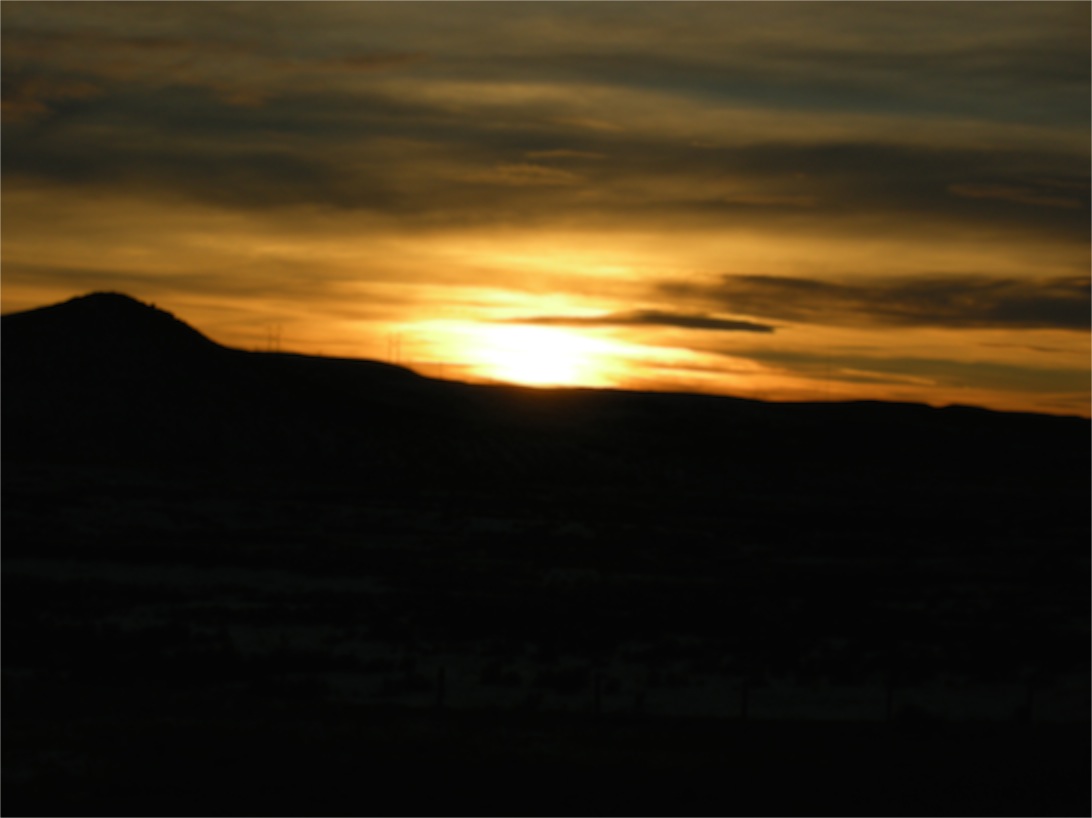
As I watched the sunset last night near Lodge Grass, south of the Greasy Grass, in the land of the Crow people, I couldn’t help but notice the promise of new beauty in new places as we journey together as the people of God.
Copyright © 2012 by Ted Huffman. I wrote this. If you want to copy it, please ask for permission. There is a contact me button at the bottom of this page. If you want to share my blog a friend, please direct your friend to my web site.
The politics of Christianity
Another reason why I don’t blog about Jesus very often is that I do not particularly feel a calling to change others’ notions about religion. I know that sounds strange, coming from a pastor, but I experience my religious calling in terms of my relationship to the people I serve, not in terms of converting others. My life of faith is not threatened by others who experience faith differently than I do. I have no need for others to have the same interpretations of Biblical texts as I.
I am aware that there are people in our society – people in the church – who see Jesus very differently than I. That comes as no surprise. From the earliest days of the church, Christians have had different opinions over who Jesus was and what his life and teachings meant. Certain stories have been emphasized in different communities throughout the entire history of the church. Different expressions of Christianity have had different interpretations of Jesus from very early after his crucifixion and resurrection.
After last week’s election, I am sure that I had members of my congregation who prayed, “Thank you, Jesus!” and other members who prayed, “Help me, Jesus!” Both groups are genuine Christians. Both are people who care about others, who believe in mission and outreach, who are committed to living lives of faith. But any careful reader of the Bible can easily see that Jesus didn’t leave clear instructions about how to organize the church, let alone establish government or exercise political power.
I suspect that there were a few sermons that referred to the election in congregations across the country yesterday. There are plenty of faithful Christians who read John 14:6 “I am the way, the truth, and the life; no one comes to the Father but through me,” as a pivotal and defining text. From their perspective, there is exclusivity to Christianity that places a mandate on Christians to convert people of other faiths to accepting Jesus as Lord and Savior. Many of those same people would interpret Jesus answer, “My kingdom is not of this world,” to argue against providing food and health care to those in need. They would argue that salvation does not come from what we do in this life and that we need to wait for a triumphant return of Christ to save the world. Their vision often includes no small amount of violence associated with the return of Christ and the end of time.
Others, just as faithful, read Matthew 25:31-46 (whatever you did for t=one of the least of these . . .) as a pivotal example of Jesus’ teaching. They note his words about care for widows and orphans and strangers as critical to the life of faithful Christians.
It isn’t difficult to go through the scriptures and find passages that appear to support a particular political belief. And it isn’t difficult to divide the Gospels into “Red Texts” and “Blue Texts.” There are plenty of Bible verses to support whatever candidate you voted for. But the church isn’t only two strains of believers. It is far more complex and subtle than a simple division of believers into a couple of factions. A simple examination of the history of denominationalism in the United States reveals that we are very practiced at arguing with one another. There are Christians in almost every political camp and there are people who use their faith to justify their political positions.
Quite frankly, I find those discussions to be a bit boring. I am far more interested in the teachings and examples of Jesus that bring us together than those that divide us. Jesus showed genuine concern for the unity of those who followed him. In the great pastoral prayer of John 17, he prays of his followers, “That they all may be one.” In Matthew, Mark and Luke Jesus called his disciples to service: “The greatest among you must be your servant.”
Jesus might not have been very clear about how his followers should participate in politics, but he was clear about how we should treat one another. He stood in the best tradition of Biblical prophets calling the faithful to return to their covenant with God, to seek justice for all people and to love neighbor as oneself.
I am relieved that the election is over. I don’t find the advertisements for mattresses and medicines to be any less annoying than the advertisements for candidates, but I do appreciate the possibility of having discussions of other matters in the cafes and coffee shops of our town. I remain convinced that the call to faithfulness would be equally clear no matter who won the election. I suspect that American Democracy is far stronger than the pundits and predictors of doom would have us believe. I know that in all things we have been called to serve our sisters and brothers. That is true in good economic times and bad. It is true in moments of victory and times of defeat. It remains our calling no matter how close to the fiscal cliff we come. It will remain our calling even if we fall over the imagined precipice.
Here is what I know. God has promised to be with us no matter what. Jesus declared in Matthew 28:20, “Lo, I am with you always, even to the end of the age.” In this post election season I have great anticipation for the beginning of Advent. The reminder of the promise of new life through God’s gift of coming to us in human terms, in human form, not as a conquering military victor, but as a baby, vulnerable and in need of care.
The politicians and pundits need to spend more time rocking babies if they want to understand the politics of Christianity.
Copyright © 2012 by Ted Huffman. I wrote this. If you want to copy it, please ask for permission. There is a contact me button at the bottom of this page. If you want to share my blog a friend, please direct your friend to my web site.
A Snowy Day
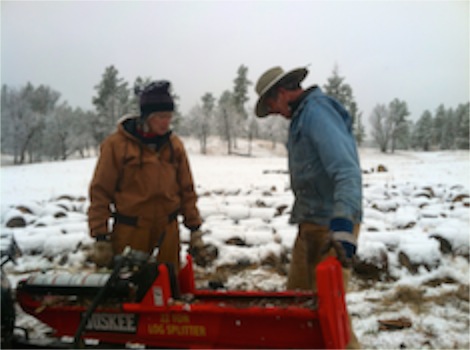
It was a delightful morning. The snow was absolutely gorgeous. There was no wind. And the temperature wasn’t too cold to work outside. We kept warm stacking the newly split wood. There are few pleasures in life that are sweeter than working outdoors with neighbors on a beautiful day.

We are generations removed from our ancestors for whom splitting wood was a necessary survival skill. Although we have wood stoves in our homes, they are supplementary heat systems. We can use other methods to keep warm in the cold weather and are not dependent upon producing a minimum amount of wood for our homes. We split wood because our neighbors need it during the long winters out on the prairies and because we have a lot of wood.
The bark beetles have been working their way through the hills. Lots of pine trees are dying from the onslaught. But in areas where there is aggressive treatment, the process can be slowed. Our neighbors had 170 trees marked last year as infected by the beetles. They cut and chunked the wood according the instructions from the foresters and this year, when the foresters came back to inspect, there were only two trees that needed to be cut. This doesn’t mean that the beetle infestation is over. The beetles are still in the National Forest and the papers say that it would take millions of dollars that the Forest Service doesn’t have in order to cut out all of the infected trees. So the beetles will spread. More trees will die. Dead and dying trees provide additional fuel in an already dry forest and we will see more fires and the fires we have will be more intense.
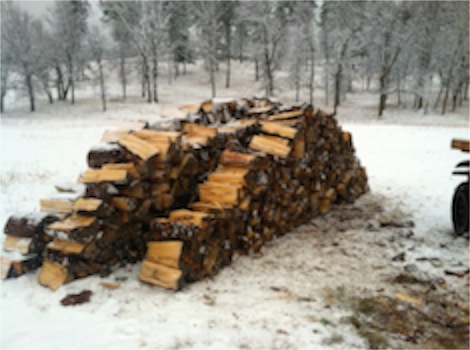
There used to be a beer advertisement that showed a gang of men sitting around a campfire drinking beer and the slogan was “It doesn’t get any better than this.” I thought that it was such a silly ad. I could think of a hundred different things that are better than sitting around drinking beer with a bunch of guys. I know that different people have different tastes, but for me, splitting wood on the first snowy day of the autumn is better than that. Sitting on the deck watching the sunrise with a fresh cup of coffee is better. Talking late into the night with my wife is better. Playing with my grandson is better. Rowing a boat that I made with my own two hands across a lake is better. I can think of a whole lot of things that are better.
The bottom line, however, is that I am an incredibly fortunate person. If I had poetic abilities, I would try to write a psalm. I understand the psalms of praise and the songs of God’s goodness. This life we have is filled with wonder and beauty and joy. It is a miracle that our eyes enable us to see depth and color in such a way that the sparkle of the snowflakes gives us joy. It is a miracle that we form friendships just for the joy of being together. It is a miracle that we can form bonds with other animals so that their antics make us laugh. It is a miracle that in the midst of a crowded world we have been given enough space to get out into the country and enjoy the silence of snow in the woods. It is a miracle that we have muscles to do work and that after decades of living we still can feel the simple pleasure of sitting down with friends after a bit of work.
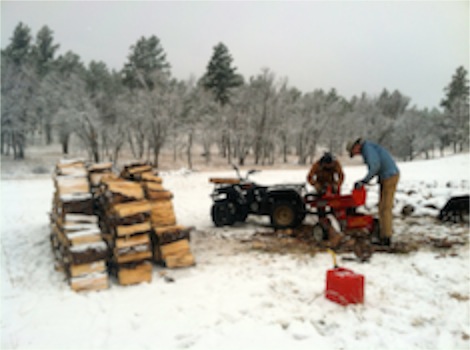
As the hymn refrain goes, “Lord of all, to thee we raise this our hymn of joyful praise.”
I’ve got just a skiff of snow to shovel this morning. It is just enough to remind me that there is work to be done, but not too much to do before heading for church. I’ll need to drive a bit more cautiously than usual. It could be a bit slippery, but the beauty that surrounds us is well worth a moment of caution. Indeed it is a hymn of joyful praise.
Copyright © 2012 by Ted Huffman. I wrote this. If you want to copy it, please ask for permission. There is a contact me button at the bottom of this page. If you want to share my blog a friend, please direct your friend to my web site.
Foreshadowing
 We’ve been living without Daylight Savings Time for a week now and we seem to have made the adjustment without any major problems. The clock that controls the bell tower at the church was successfully changed. The bells ring at the right time. People have been showing up for meetings at the right time. The church office hours were observed. We’ve been making the change for so many years that most of us don’t think about it very much..
We’ve been living without Daylight Savings Time for a week now and we seem to have made the adjustment without any major problems. The clock that controls the bell tower at the church was successfully changed. The bells ring at the right time. People have been showing up for meetings at the right time. The church office hours were observed. We’ve been making the change for so many years that most of us don’t think about it very much..The shift means that it gets dark earlier in the evening. Sunset was about 4:30 yesterday and sunrise will be about quarter to seven this morning. The times also reflect the short days and long nights of approaching winter. We’ve got more than a month of shortening days ahead of us as we enter the darkest season of the year.
The dramatic shift of one hour in a single day resulted in my noticing the approaching dusk and the lengthening shadows more than usual. As I went through my afternoon activities this week I was aware of shadows. The weather has not been bright and sunny all week. In fact yesterday it was foggy and misty all day long. So the shadows are not the stark, long companions that we are used to when it is bright and clear and the sun sinks low enough to create elongated shapes on the ground. Rather, the world seems to be full of dark places with insufficient light to see what is happening. Driving in the fog after dark yesterday was an experience of dwelling in a world that is mostly shadow.
The name “Dark Shadows” was chosen for a popular movie directed by Tim Burton and starting Johnny Depp and Michelle Pfeiffer. I am not much of a moviegoer and I haven’t watched the picture, but I’ve read a couple of reviews and there isn’t much in what I have read to attract me to the show. A vampire who has been imprisoned is somehow set free and returns to his ancestral home where he works to save his descendants. Not believing in vampires, the basic premise of the show eludes me, but I understand that vampires are very popular in contemporary culture. We like things that give us a fright without really being dangerous. I’m not much for scary movies or for thrill rides at amusement parks. Life itself has enough experiences of real danger to satisfy my need for adrenalin. Driving in the dark in the fog on slippery streets with inexperienced drivers during the deer rut is enough to garner my attention. Who needs a movie to raise the hairs on the back of your neck?
But I like the name “Dark Shadows.” Actually, I think the movie got the name from a 1960’s TV soap opera. I don’t watch soap operas either.
Shadows are not reserved for unlit corners and television and movie portrayals. Foreshadowing is a long-established literary technique. Shakespeare was a master of it. Early in the story of Romeo and Juliet, both partners declare that they would rather defy their families and be in love. Their declarations set up the drama that is to follow. Foreshadowing is common in novels and in movies. One of the classical uses of the technique is the music used in the 1975 movie Jaws. It has been decades since the film was made and still people will mimic the soundtrack of the movie to indicate that something dramatic is about to occur.
Foreshadowing is also a parenting technique. Most parents employ foreshadowing without even thinking about it. They simply talk about what is going to happen as a way of preparing a child for the events of the day. A parent will casually mention upcoming events to motivate a child: “After you get dressed, we are going to go visit grandma.” The promise of a reward motivates behavior in advance of the reward. The problem with the technique is that at different ages and stages of development children have less or more ability to envision the future. A two-year-old, for example, might have a notion of now and the future, but can’t conceptualize something that is weeks or months in the future. “Is it my birthday, yet?” starts right after the second birthday. The next birthday is a half a lifetime away from the perspective of a two-year old. I’ve often witnessed parents rattling off a list of events and the child focusing on one of the events while ignoring the rest. For example, a parent might say, “After breakfast we are going to clean the house. Then we will eat lunch, take a nap and after that we’ll go swimming.” The child finishes breakfast and goes immediately to put on her or his swimsuit, forgetting all of the other things that the parent described.
We all have limits to our ability to delay gratification. Foreshadowing helps us to deal with the delay. When I remind myself that something good is coming, I have more energy for the mundane tasks that lie between the present and the reward.
But there is a big difference between fiction, such as a novel or a movie, and real life. In real life there are genuine surprises. A movie director or novelist has to know what is coming in order employ foreshadowing. In real life, we often do not know what events are ahead. Starting a day with one set of expectations and ending it with an entirely different set of experiences is common in my life and work. Things are continually happening that surprise me and change the direction of my actions. Sometimes I will comment to a friend or colleague that my life needs a soundtrack. It would be nice to have dramatic music to warn of surprises or dangers that lurk ahead.
The bottom line is that we don’t know the future.
But I think there is a bit of foreshadowing in our lives. Experiences of love give us a glimpse of the love of God. Times of drawing close to God give us a sense of the realm that lies ahead. Facing the deaths of loved ones gives clues to the facing of our own deaths.
It may be that what we need is to listen more carefully for life’s soundtrack. In my case, I need a bit of silence every day to listen. When I make sufficient time for quiet I am always reminded that there is something good that lies ahead.
Copyright © 2012 by Ted Huffman. I wrote this. If you want to copy it, please ask for permission. There is a contact me button at the bottom of this page. If you want to share my blog a friend, please direct your friend to my web site.
Life in community
My day began with an 8 a.m. meeting of the Human Rights Committee at Black Hills Workshop and Training Center. I have served on this committee for quite a few years, now and I enjoy the work. It gives me connection with members of our community who are often unseen and unnoticed by many in our community. From there, it was off to United Blood Services where I was able to donate platelets, plasma and whole blood. The experience is always a kind of break in my day because mostly what I have to do is lie still and squeeze my fist from time to time. Donating on the apheresis machine takes longer than just donating blood, so I have time to read a book. Yesterday I had time to read several chapters of a book that we are discussing in our clergy book study group. I had been behind in the reading of that book and it was good to get caught up and even just a little ahead in advance of next week’s discussion.
I checked in at the office and dealt with e-mail and phone messages, ran some errands that facilitate the rest of the week in the church’s life and soon the day was nearly over. I ended my day with a meeting of the Board of Directors of the Black Hills Chamber Music Society. It was after 9 p.m. when I turned my key to lock the church and got in my car to head home. The length of the day was typical for me.
It is often hard to know exactly when I am working for the church and when I am doing volunteer activities in the community. The distinctions are clear in some vocation, but less so in mine. Part of this is due to the luxury of a flexible schedule. I am expected to get my work done, but I do not work according to a time clock. When the job demands extra hours I simply put in the extra hours. When there are gaps in the work that allow for other activities, I take advantage of those gaps.
None of this is unusual and my life isn’t all that different from my colleagues, and it seems hardly a topic worthy of a blog entry, but I have known many who live in a community for years but don’t really become connected to that community. I’ve just finished Josh Davis’ book about the Great Plains and am left with a sense that this young man, who is a brilliant writer, a solid researcher, and a keen observer has ended up writing a book that comes off as a narrative by an outsider. Lots of people live on the plains without becoming a part of the community. This isn’t a book review, but one brief example serves to illustrate. Davis insists on using the technically correct term to refer to some of the plains animals. The critters commonly known as buffalo he calls American Bison. What locals call antelope, he insists should be called pronghorns. He is technically correct. He also creates a barrier between himself an a Harding County rancher who immediately knows that Davis speaks a different language. Insisting on being correct isn’t always the best way to listen to one’s neighbors.
I see it frequently in the many pastors who come and go from our town. Some of them have more authentic credentials as people of the plains than I. I have been a nomad in my life and I can’t really claim to be a native. But I know the language of the people I serve. I understand the ranchers at whose funerals I officiate. I can speak the language of the law enforcement officers when I am offered an opportunity to ride along with them in their work. I have spent enough days working in shops to get along well with the technicians who service my car and have been around sales enough to exchange banter with the sales staff in the front. I don’t say any of this to brag. It is just that I see colleagues who come to serve churches and work so hard to establish separation. They flaunt their educations, enjoy being addressed with titles, and are quick to name tasks that are beneath them. It always distresses me when I hear a pastor say, “I don’t do Sunday School,” as if there could be a church without a culture of teaching and learning. I not only enjoy Sunday School, I’m the one they call to get the toilet plunger when a child tries to flush something that just won’t go down. I have never experienced myself as too good to clean up a mess or too busy to fix something that is an easy repair today and an expensive item if left unattended.
In sort, I am very much like the people I serve. And so I work to keep the organizations and institutions of our community healthy. I give of my time and go to more meetings than I like some days. I roll up my sleeves and show up for the workdays and get out my checkbook when the fundraisers come around. It is not because I am somehow indispensible to the community. It is because it is what we all do. We all share in the life of our community.
As a result I am treated as an equal even though I didn’t grow up in this town. I am accepted as a member of the community even though I came from somewhere else. And someday, when I write a memoir, I pray that it will be of this place and not just about this place.
And Josh, I know you are right. But I have no intention of singing, “O give me a home where the bison roam, where the deer and the pronghorn play . . . “
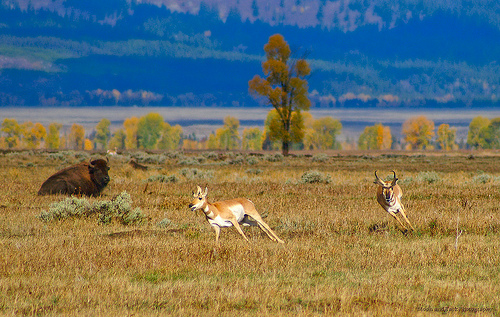
Copyright © 2012 by Ted Huffman. I wrote this. If you want to copy it, please ask for permission. There is a contact me button at the bottom of this page. If you want to share my blog a friend, please direct your friend to my web site.
Sand-between-the-toes
The way I remembered it was, “Whenever a good nor’easter bows, Christopher is certain of sand-between-the-toes.” I don’t know what I was thinking. A.A. Milne, and therefore Christopher Robin and Winnie the Pooh, Tigger, Piglet and the rest would have lived in England, where fowl weather comes from the northwest. I somehow had transplanted them into the New England states where storms come from the northeast. I would have known better, had I taken time to think about it, but my memory is often not in the same part of my mind as my rational thinking.
Here is the real poem:
Sand-Between-The-Toes by A.A. Milne
I went down to the shouting sea,
Taking Christopher down with me,
For Nurse had given us sixpence each –
And down we went to the beach.
We had sand in the eyes and the ears and the nose,
And sand in the hair, and sand-between-the toes.
Whenever a good nor’wester blows,
Christopher is certain of
Sand-between-the-toes.
The sea was galloping grey and white;
Christopher clutched his sixpence tight;
We clambered over the humping sand –
And Christopher held my hand.
We had sand in the eyes and the ears and the nose,
And sand in the hair, and sand-between-the-toes.
Whenever a good nor’wester blows,
Christopher is certain of
Sand-between-the-toes.
There was a roaring in the sky;
The sea-gulls cried as they blew by;
We tried to talk, but had to shout-
Nobody else was out.
When we got home, we had sand in the hair,
In the eyes and the ears and everywhere;
Whenever a good nor’wester blows,
Christopher is found with
Sand-between-the-toes.

I do like the poem. I love the sense of adventure. I love the delightfully warm relationship between an adult and a child. I love the notion of teaching one’s children about the world and helping them to overcome their fears. Even though a storm is raging, the child is safe. The gales that chase others from the beach are no match for the love of family. The world is a place that is safe and worthy of adventures that bring you home in need of a bath and a warm meal. It is worth going out to explore even when you know you’ll be coming home with sand-between-the-toes.
I remember sand in the eyes and the ears and the nose, and sand in the hair, and sand-between-the-toes. I remember the bathtub so full of sand that I worried about washing it all down the drain. We raised our children with plenty of outdoor adventures. We went to the beach and flew kites and made castles and chased waves and examined shells and rocks polished by the surf.
But today I am thinking of parents on another coast, where the storm is raging not from the northwest, but from the northeast. When our children were little the longest power outage I can remember was about three days. We had plenty of flashlights and batteries. We had a few candles for the dinner table. We had a woodstove to keep the house warm and a camp stove to cook warm food. We had plenty of provisions and were in no danger of running out. And we knew that even though our street was temporarily blocked by a spring blizzard, help was only a phone call away. If needed, the county would send a snowplow and an ambulance.
It is different for families who watched the water fill the lower floor of their home while they huddled upstairs. They have been trying for days to survive without electricity, with limited access to gas and groceries. And now a nor’easter is whipping the region and dumping snow and dropping power lines from Delaware to Maine. Up to seven inches of snow was expected on Staten Island by this morning. Parts of Connecticut saw more than eight inches. There are hundreds of thousands of people without electricity in New Jersey and New York.
I know that we are a resilient lot. I know that we often have far more luxury than is necessary for survival. I know that we have become soft and spoiled by the ease of access to warmth and food. I know that all of us should take more precautions and be more prepared for the storms that inevitably come. I know that forecasters have predicted these storms would come. I know all of that.
But how do you explain it to a child? How do you provide a sense of safety and security? How do you teach the joy and wonder of this world when nature is delivering a one-two punch and the temperatures are dropping and your home is not some secure and independent cabin in the woods, but an apartment dependent upon public utilities to keep it warm and a car to commute to the work and services upon which your life depends?
I think if I were a parent in some of those locations, I might gather up my child, a few cherished toys and a few good books and head to the home of another family member or, if necessary to a shelter, where I could at least provide warmth and safety for my child.
Chances are, among the books I would grab would be “When We Were Very Young,” and perhaps “Now We are Six.” When the world becomes unsettled, it is always good to have the classics. Who knows? It might even be fun, once a warm meal and a safe bed has been found, to read the poem and change the worlds to nor’easter and then to check for sand-between-the-toes. Our kids always giggled when I checked for sand-between-the-toes.
If we fill our lives with love and remember what is most important, we can weather life’s storms, even the severe ones. We are survivors. And sand-between-the-toes makes for good stories to tell our grandchildren.
Copyright © 2012 by Ted Huffman. I wrote this. If you want to copy it, please ask for permission. There is a contact me button at the bottom of this page. If you want to share my blog a friend, please direct your friend to my web site.
Post election politics
The election, however, is the dominant subject in the news today and it has been the dominant subject in my conversations with friends and church members over the past few days. It seems appropriate to offer a few comments, for what it is worth.
Despite the way the presidential campaign felt, with the candidates focusing on a few key states and ignoring the rest of us, we all participated in the election. South Dakota is identified as a red state and the campaigns of both parties assumed that our electors would be voting for Governor Romney and Senator Ryan. In that climate it is important to remember that 39% of South Dakotans voted for the reelection of President Obama and Vice President Biden. The fact that the majority voted in the manner predicted doesn’t mean that those in the minority have ceased to exist. 39% of South Dakota represents a lot of people and they are our friends and neighbors as surely as those who voted Republican.
A similar reality should be noted by our lone Representative. Kristi Noem handily won reelection to a second term in the United States House of Representatives. But 42% of her constituents who voted cast their ballots for Matt Verilek. She has been elected, but she would do well to remember that a significant slice of the people she represents do not share all of her views. An effective representative goes to the legislature with more than her or his personal views. It is easy to represent those with whom you agree. It takes a real stateswoman to represent all of the constituents.
Our political map remains very similar to the recent years. Republicans control the House of Representatives. Democrats hold the majority in the Senate. We have all of the makings of another season of political gridlock. The politics of opposition give their players considerable power to block legislation. History, however, will not be kind to those who only obstruct. The American people expect and deserve more from our legislative branch of government.
I know these things in part because I serve a diverse congregation. I don’t know the exact percentages and I suspect that we aren’t quite typical of the whole state of South Dakota, but I do know that I have ardent supporters of both political parties in my congregation. I serve people who voted both ways on nearly every choice that was put before the voters.
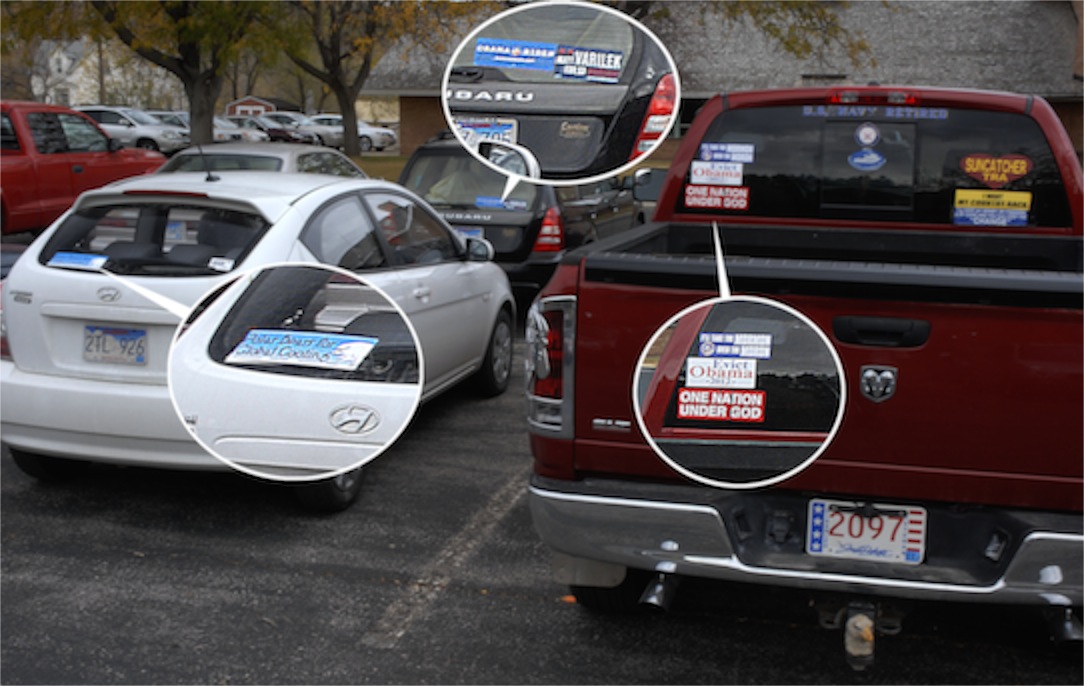
A few weeks ago, church member Kenny Putnam snapped a picture in our church parking lot that says quite a bit. In a single photograph he captured cars sprouting bumper stickers for and against the president, for the two major candidates in the house race, and an environmental message. Were we to photograph all of the cars in the parking lot, there would be a lot more opinions. And the majority of the members of the congregation don’t display their political opinions on the windows and bumpers of their cars.
As pastor of the congregation, I don’t mind telling our members how I vote, but I don’t presume to be able to tell them how they should vote. I am aware that not every pastor agrees with me. I have colleagues who are less than subtle in trying to influence the votes of the members of their churches. And I know a lot of congregations that tend to be collections of people who agree with each other on theology and politics.
At this point of my life, I have little interest in serving a congregation where the people always agree with each other. Sure, there can be some awkward moments as I try to serve people who see things in a radically different way than I do. Yes, I end up reading a fair amount of forwarded e-mail that is, in my opinion, objectionable. On occasion, I have even thought of subscribing a couple of the members of my church to each other’s e-mail distribution lists. They both have sent me e-mails vilifying opinions taken by the other.
But I don’t want us to be the same. I don’t want us to always agree. I don’t want to quiet the voices of those who have different opinions. And even though I am sometimes disturbed by the members of the congregation who would like to have me move on and another pastor come to replace me, I don’t want to purge the church of those members. I want to be the pastor of a congregation that honors, respects and empowers all of its members.’
Each week we say these words, “No matter who you are or where you are on life’s journey, you are welcome here.” I really mean it. I believe that most of the members of our congregation really mean it. If it is to be more than a cheap slogan it has to mean that we welcome those with whom we disagree.
Our country is a complex and diverse group of people. A government forged out of the slimmest of margins is appropriate. A mixed legislature is a reflection of who we are. It is no great thing to elect a divided house. Greatness is getting to work with those with whom you disagree and solving the problems in spite of the disagreements. The American people did not vote for gridlock yesterday. We voted for a government that reflects our wonderfully diverse nation.
Now that the election is over, we expect our representatives to pay more attention to their constituents than to their donors. We expect them to reach across the aisle and work for bipartisan solutions.
We do it every week in our church.
I’m not a politician. I won’t be elected because I have no intention of running. But if I were heading to Washington DC to serve in the House or Senate, I think I’d take time to organize a choir for our legislature. It works at church. Our choir contains Right-wing Republicans and Liberal Democrats. And they sing together with beautiful harmony. A little harmony in Washington would be welcome. And there are some who won the election who wouldn’t be hurt by singing a new tune.
Copyright © 2012 by Ted Huffman. I wrote this. If you want to copy it, please ask for permission. There is a contact me button at the bottom of this page. If you want to share my blog a friend, please direct your friend to my web site.
Election Day
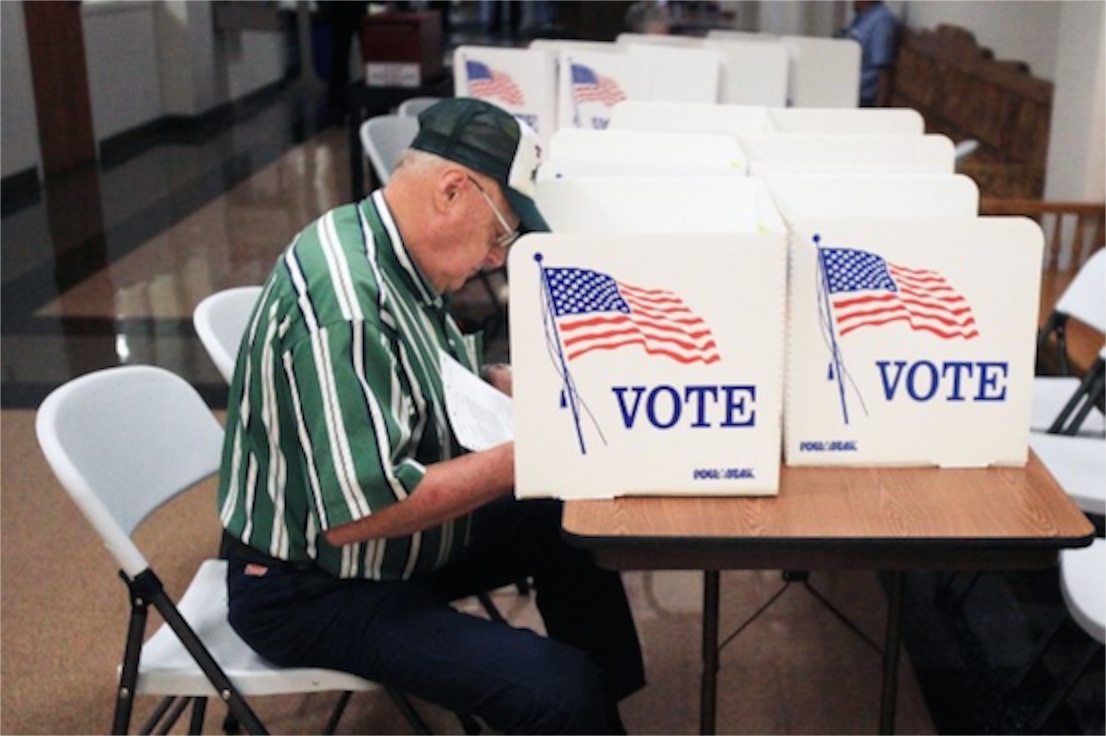
It isn’t hard to become cynical about elections. It seems like it has been a long time since a candidate gave a reason to vote for him or her. What we hear are reasons to vote against the opponent. It is hard to associate with the process of elections because of the millions and millions of dollars that are spent. South Dakota, like many other states is flooded with out-of-state money each election season. It seems that our candidates have to bow to the money sources in order to compete. Then we wonder if there is any independence left in them once they get elected. The nicest, most genuine and sincere person seems to end up distracted and beholden to other interests by the time that person gets elected. The national races are decided in a few “swing” states. The candidates ignore states like South Dakota, whose voting pattern in a presidential race is fairly easy to predict. Our Electoral College votes are taken for granted. I heard of a South Dakotan who called a presidential campaign office in Sioux Falls to obtain a yard sign and was told that the office really existed only to work the campaign in nearby Iowa.
It isn’t just the negative ads, which are disturbing enough on their own. It is the conviction, held by candidates of both parties, that lying works. While they claim to tell the truth, a simple check of the facts catches an alarming amount of just plain lying in political rhetoric. It is not just a false portrayal of the opponent, which is common enough. Candidates distort the truth about virtually every aspect of our culture and society. It is no mystery that we don’t trust our political leaders. Trust has to be earned.
Then there is the shift created by early voting. There really isn’t a single election day any more. People can vote by mail and fax in some states. Here the polls have essentially been open for weeks as people are able to vote absentee without really being absent on Election Day.
For whatever reasons, I have chosen to wait until today to vote. I still like the mood of going to my neighborhood fire station to cast my vote in person. The people who volunteer to staff the polls are my neighbors and those waiting in line are familiar to me. I plan to vote near the opening of the polls this morning, so I expect a short line to vote as I join others who are voting on their way to work in the morning. Were I to take a break in the middle of the day, I would be able to walk right in and vote without any wait at all. We don’t really have that many people in our precinct and a lot of us will be at work in the middle of the day.
Still, I feel that voting is important. I have a sense that it is a privilege and a responsibility. My track record at voting is pretty consistent. I am honored to cast my vote in each election.
Over the years, I have cast a lot of votes for candidates who did not win. Although I feel connected with my neighbors, I often vote differently than the majority. I feel no need to be counted with the majority. I am very careful to consider the issues that are most important to me. I also try to carefully consider the interests of the entire community.
A bit of the cynicism remains, however. It seems to me that people who speak as if they are selfish are just as likely to vote against their own self-interest as anyone else. People will say they are concerned about the deficit and vote for a candidate who advocates unlimited spending in part of the budget. People will say that they are concerned about security and then vote for a candidate who engages in foreign policy that makes the country less secure. People will say that they are in favor of small business and then vote for a candidate that is beholden to big business and ignores everything that is small. We humans are a strange lot.
Of course there is nothing very innovative in our behavior. The book of Exodus is filled with stories about how the newly freed former slaves keep rejecting the God of freedom. After God clearly demonstrates that the road to freedom is based in faithfulness, the people immediately begin looking for shortcuts. Over an over again they choose to limit their own freedom. Within the span of Old Testament history our people go from the oppression of Pharaoh to the oppression of corrupt kings who are more interested in the consolidation of wealth and power than they are in justice. The prophets call the people to return to faithfulness and the people ignore the needs of the widows and orphans in their midst.
The story of Christianity is also filled with demonstrations of faithlessness. Jesus gives every reason to reject worldly goods, but there are many examples of the church seeking wealth. Jesus rejects the trappings of rule-based theology but his followers construct a church filled with rules as if salvation were a matter of following rules.
It is a simple fact that we often are inconsistent in our behavior, in our allegiances, and in our decisions.
In less than two hours I will have completed my voting and will get on with my day. Despite my best intentions, I’ll keep checking the computer throughout the evening for news of the election results. I’ll wake tomorrow and check the close races again. I do care. But I have lived long enough to learn that our democracy is stronger than any one candidate or any single election. Our nation can survive the election of a less-than-optimal leader. Even when partisan politics brings the legislative process to a near halt and our government becomes sadly dysfunctional, we can still reach out with compassion and work together to help our neighbors.
I will vote with my ballot today. And the rest of the time I will vote with my behavior. I will not be elected. I’m not running. But I will serve. That is my vocation.
Copyright © 2012 by Ted Huffman. I wrote this. If you want to copy it, please ask for permission. There is a contact me button at the bottom of this page. If you want to share my blog a friend, please direct your friend to my web site.
Blood type
There are, however, some supplies that are more difficult to stockpile. Human blood, necessary for the treatment of a variety of illnesses and injuries, has a limited shelf life. Red blood cells can be stored a maximum of 42 days. Platelets must be used within five days. Only plasma, the liquid component of blood, can be stored long term. By freezing, it can be stored up to a year. So the way to prepare and respond to the need is for people to donate regularly. The need in the United States alone is 4.5 million people each year. Break that down and it means that someone needs blood every two seconds.
But less than 10% of the population of the United States donates blood at least once per year. So I try to do my part. I donate whole blood at least four times each year and donate platelets and plasma more often. The people at our local United Blood Services donation center know me by name. I’ll be there Thursday morning. I have healthy bone marrow that makes a constant supply of red cells, plasma and platelets, so I have plenty to share each time I arrive at the center.
It is very important to me to engage in this particular form of volunteer giving. As opposed to other charitable giving, which is also important to me, donating blood is different because it is literally giving part of myself. When I give a financial donation, it is a gift of my resources. Giving blood is giving myself – symbolically sharing my life – without any expectation of anything in return. OK, I do accept the free t-shirts that the blood center gives me.
My blood type is O positive, which is the most common blood type in the United States. That also means that it is the most often needed blood type. O negative is considered to be the universal donor of red blood cells, those can be received by people with other blood types.
Most of the time I don’t think about my blood type. It is simply a small part of who I am, information that is useful only when I donate blood, plasma or platelets.
But blood type is a big deal in Japan. The Japanese believe that blood type determines personality. Four books describing the different blood groups characteristics became a huge publishing sensation, selling more than five million copies. I don’t read Japanese, and they haven’t been translated, so I haven’t checked them out. In general, popular belief in Japan holds that type As are sensitive perfectionists and good team players. They do tend, however, to be over-anxious. Type Os are curious and generous but stubborn. Abs are arty but mysterious and unpredictable. Type Bs are cheerful but eccentric, individualistic and selfish. A year ago Minister for Reconstruction Ryu Matsumoto resigned after being criticized for making insensitive remarks. He blamed his blood type: “My blood’s type B, which means I can be irritable and impetuous, and my intentions don’t always come across.”
The women’s softball team that won gold for Japan at the Beijing Olympics used blood type theories to customize training for each player. In Japan, some kindergartens adopt different teaching methods for different blood types. Companies make decisions about assignments based on employees’ blood types. Mitsubishi Electronics has a team of workers composed entirely of people with AB blood type believing that they have exceptional planning abilities. Many employers routinely ask blood type as part of the job interview process.
I don’t know why this obsession with blood type is so common in Japan and practically unheard of in the rest of the world. Perhaps this obsession comes from the observation that blood types are a bit atypical in Japan. In the United States and Europe the most common blood type is O, while in much of India and Asia, the most common blood is type B. In Japan there is quite a bit of variety, with Type A being the most common with 40% and type O accounting for about 30%. Type B represents about 20% of the population in Japan.
Looking at Japan as an outsider, the obsession with blood type seems almost like a kind of racism. Assumptions are made about people based on unproven assumptions about something over which they have no control. You can’t choose your blood type. It is just something with which you are born. To claim that someone is bad or good based on blood type is just a form of prejudice.
Having books written about something doesn’t mean that it is the truth. There have been plenty of books that have perpetuated false notions about race.
Blood type is simply determined by proteins in the blood. For most of human history we have been unaware of different types. It was only in 1901 that the blood type system was discovered. That discovery led to making safe blood transfusions common medical practice. By the 1930’s theories of eugenics were appearing in Germany and in Japan, with the belief that some blood types were superior to others. The government of Japan adopted eugenics as official policy during the 1930’s forming battle groups by blood type during the Second World War. Vestiges of this obsolete and frequently debunked theory still remain.
The aftermath of a storm, however, is something that Japan recognizes, having suffered so greatly in the aftermath of the March 2011 earthquake and tsunami. Suffering and recovery demand that people pull together and get beyond their differences.
So, as our neighbors dig out from Sandy, I’m heading to the donation center. I’ll offer the only type of blood that I have. I am confident that it will help.
Copyright © 2012 by Ted Huffman. I wrote this. If you want to copy it, please ask for permission. There is a contact me button at the bottom of this page. If you want to share my blog a friend, please direct your friend to my web site.
Time
As I was walking down the street one day
A man came up to me and asked me what
The time was that was on my watch, yeah...And I said
(I don't) Does anybody really know what time it is
(Care) Does anybody really care (about time)
If so I can't imagine why (Oh no, no)
We've all got time enough to cry
And I was walking down the street one day
A pretty lady looked at me
And said her diamond watch had stopped cold dead...And I said
(I don't) Does anybody really know what time it is
(Care) Does anybody really care (about time)
If so I can't imagine why (Oh no, no)
We've all got time enough to cry
And I was walking down the street one day
Being pushed and shoved by people trying to
Beat the clock, oh, no I just don't know
I don't know, and I said, yes I said
(Background:)
People runnin' everywhere
Don't know where to go
Don't know where I am
Can't see past the next step
Don't have time to think past the last mile
Have no time to look around
Just run around, run around and think why
(I don't) Does anybody really know what time it is
(Care) Does anybody really care (about time)
If so I can't imagine why (Oh no, no)
We've all got time enough to die
Everybody's working (I don't) I don't care (About time)
About time (Oh no, no) I don't care

So today we end Daylight Savings Time. If you forgot, check you watch against your cell phone. These days almost all of us have a number of devices that set their clocks all by themselves. It wasn’t that long ago when you had to reset the clock in your computer. Then a few years later the operating system at least asked you if you wanted to change the clock. These days, it just changes. The clock in the cell phone changes by itself and so to a number of other automatic clocks that people have.
There are still a number of clocks that have to be dealt with manually. One of the hardest to set is the clock that manages the bell in our church. It is a complex, seven-day, twenty-four-hour clock that cannot be turned backwards. The option of pushing the clock ahead through all seven days exists, but it is far simpler to turn off the power for a little more than an hour and then move the clock ahead to the precise time.
From time to time I still hear complaints about Daylight Savings Time. And there are some places where it causes confusion, like Arizona, where it isn’t observed. So when it is Daylight Savings Time in Western South Dakota, it is an hour earlier in Arizona, as if it were in Pacific Time Zone. Now that Daylight Savings Time has ended, it is the same time in Arizona that it is here. All of that is further confused by the simple fact that South Dakota occupies two time zones and the line doesn’t quite follow the river, so you have to check to see what time it is in certain towns.
Time is a very arbitrary human construct in the first place. Our clocks are roughly based on the amount of time it takes for the earth to rotate. As early as 2000 BC, the Egyptians had divided daytime and nighttime into twelve hours each. Being closer to the equator, days and nights were nearly the same length. The Hellenistic astronomers Hipparchus (150 BC) and Ptolemy (150 AD) didn’t use minutes or seconds, but divided the days (1/4, 2/3, etc.). They used time-degrees of 1/360 of a day or four minutes as the smallest unit of time.
It wasn’t until the later half of the 16th century that mechanical clocks recorded seconds.
These days there are atomic clocks with astounding accuracy that are used as the basis for time measurement. The problem with this great precision in time measurement is that the earth isn’t quite so precise in its rotation or its orbit. So, we base our measurement of time on the movement of the earth, but we are able to make clocks that are more precise than the earth’s movement, so the two do not always agree.
None of this has any deep practical meaning for most of us who have no real need to know precisely what time it is. About the right time is good enough for most of us. The people in my church like worship to start and end on time, but they aren’t picky enough to make a fuss over a minute or two. With cell phones we are probably more precise than once was the case, but we don’t need to get too much hung up on time.
The real time that we seem to want to know is how much we have left. Like young children we often wonder, “How long until . . . ?” Sometimes we can envision events that are a bit farther off than young children. In addition to “how long until dinner?” we pause to consider “How long until my vacation?” or “How many years before I retire?” All of those questions hid the big one, “How long until I die?” And there is no answer to that last question. At least there is no way of precisely knowing the answer. Even in the case of severe illness, there are too many variables to know the precise time of dying.
So we set our watches and we keep our calendars and we find various ways of dividing up our days into manageable ways of understanding time. The song really has the right question, however: “Does anyone really know what time it is?”
Copyright © 2012 by Ted Huffman. I wrote this. If you want to copy it, please ask for permission. There is a contact me button at the bottom of this page. If you want to share my blog a friend, please direct your friend to my web site.
At home in South Dakota
On my mother’s side parts of the family have settled down after her grandparents migrated to Montana. There are still family members on the original homestead more than a century and a quarter after relatives arrived with the steamboats making their way up the Missouri River to Fort Benton.
I have followed in the family tradition, leaving our home for college and from their leaving the state. Including the state of my birth, I have lived in five states and I stayed a decade or more in three of them.
I have felt the suspicions that are directed toward newcomers. I know how natives can wonder whether a newcomer will ever fit into a community. Still, I feel myself to be a South Dakotan at this point. I claim my membership in the community and think I have a basic understanding of life in the hills and on the plains. Knowing that I cannot claim “native” status doesn’t really bother me. I have been called to live and minister in the midst of the people and it seems to me to be a good fit. As ministers go, I’ve been pretty stable. Most of my colleagues moved to town after I did.
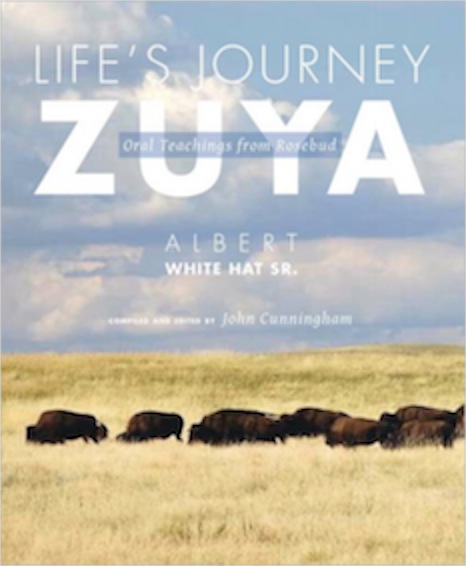
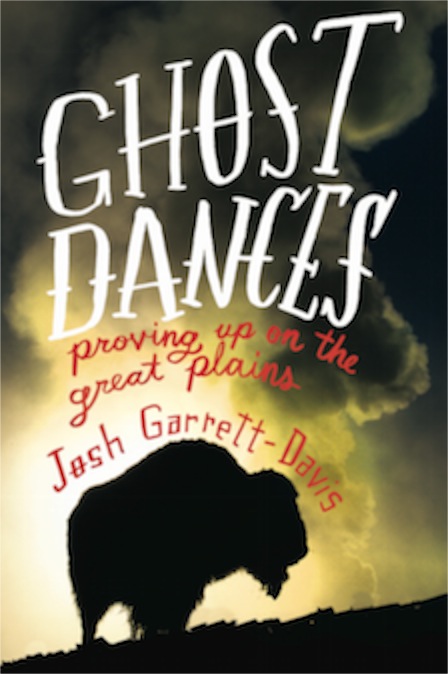
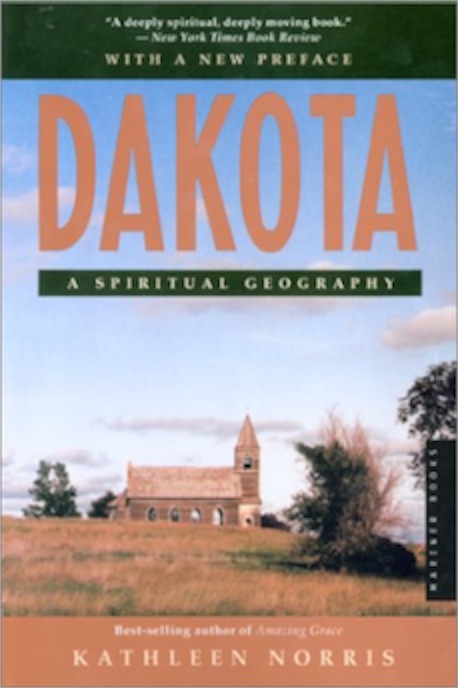
Although her living has been earned as a writer and not a rancher, I think that Kathleen Norris does a very good job of understanding, appreciating and living the culture of South Dakota.
There is, however, a sense in which none of us fully understands this place.
Davis is the son of parents who weren’t native to South Dakota. His father comes from the east, his mother from the west. Neither was what one might call “mainstream.” And Davis is clearly writing about South Dakota as one who has chosen to leave. He hasn’t cast his lot with the people of this place. His seeking to understand South Dakota is part of a quest to understand himself.
In a rather strange way, Albert White Hat, Sr., also presents books that don’t quite tell the story of South Dakota. Part of it might be the fact that each of his books is produced with a different co-author or editor and none of his co-writers are South Dakotans. The Rosebud attracts a steady stream of spiritual tourists who come to the reservation to learn something of Lakota Culture, to seek some meaning from contact with Indigenous people, and to try to understand. But these folks, while perhaps forging life-long friendships, never stay. They spend some time on the Rosebud and go on to more luxurious lifestyles in other places. Their distinct non South Dakota realities enter into the writing. But on a deeper sense, even a Lakota Elder doesn’t fully belong to one place. Like my ancestors, the ancestors of Lakota people were nomadic. Although they arrived in the Dakotas more than a century before Europeans, they come from a lineage of wanderers who lived in many different places.
We are shaped by the land, but in a sense we never belong to any one place. Ever since Abram and Sarai set off to the land that God was to show them, our history has been more than one place. Maybe none of use really understands South Dakota. The power of the hills, badlands and plains is beyond any individual. Maybe each life is a strange combination of “fitting” and “not quite fitting” in the same place. Maybe the Psalmist got it right when he observed that our home isn’t a place at all: “Lord, thou has been our dwelling place in all generations.”
Copyright © 2012 by Ted Huffman. I wrote this. If you want to copy it, please ask for permission. There is a contact me button at the bottom of this page. If you want to share my blog a friend, please direct your friend to my web site.
Midweek road trip
While New Yorkers and others on the east coast lined up for gas at the few stations that had power and tempers flared in the long lines, there was no line at 6:30 a.m. at the local Safeway gas station and I filled up for our trip. My companion for the day was a little early arriving at the church and I saw his pickup heading up the hill just ahead of me. The trailer was loaded and within a few minutes we were heading out of town.
Not much longer we were driving in fog and speculating about how long it would take for the fog to burn off. I recalled a conversation I had last summer with a couple traveling by RV who were heading from Kansas City to Medora, North Dakota. I had suggested that they go through the Black Hills one way, but they were reluctant, fearing the 185 miles of two-lane highway from Spearfish, SD to Bellfield, ND. “We don’t like to get off of the Interstate,” they declared.
It might have been fun to have them along as we exited the Interstate after less than 30 miles and headed east on South Dakota 34. The fog rolled in and out. In some places we were down to 50 mph or so because of reduced visibility. We were at Howe’s Corner by 9 a.m. Howe’s corner isn’t one of the big communities of the prairie and we often stop and use the pit toilets without seeing anyone else. The place was fairly buzzing with a half dozen trailers and campers set up with hunters eager to get out for the deer season opener. There were no pickups at the campers, however and we knew the hunters had gone out early. The fog, however, was giving us a clue it wasn’t going to be a good day for hunting.
15 miles north of Howe’s Corner we left the paved road behind and turned on to Red Scaffold Road. Ziebach County, according to many sources, is the most impoverished county in the United States. About 25 miles down the gravel road we arrived at Frazier Memorial Church. A quarter mile down the road is the home of Matt Iron Hawk, where we unloaded a trailer of firewood. Matt and his son-in-law helped us stack the wood and it was a short job. We went up to the church and unloaded one of the organs we had in the back of the pickup. After struggling to get the spinet legs reattached to the organ, we plugged it in and Matt played a few songs to make sure that everything was working.
From there it was east about 5 miles on the gravel and north another 25 miles to Dupree, the county seat of Ziebach County and the home of the headquarters of the Cheyenne River Sioux Tribe. At Dupree the fog was so thick we couldn’t see a block down the street. So much for the theory that the fog would burn off. We didn’t see much scenery for the 20 miles into Eagle Butte. If it had been a person’s first trip to the area, that person wouldn’t know that there is a water tower in Lantry. At Eagle Butte we couldn’t see the clinic from the Eagle Butte Learning Center.
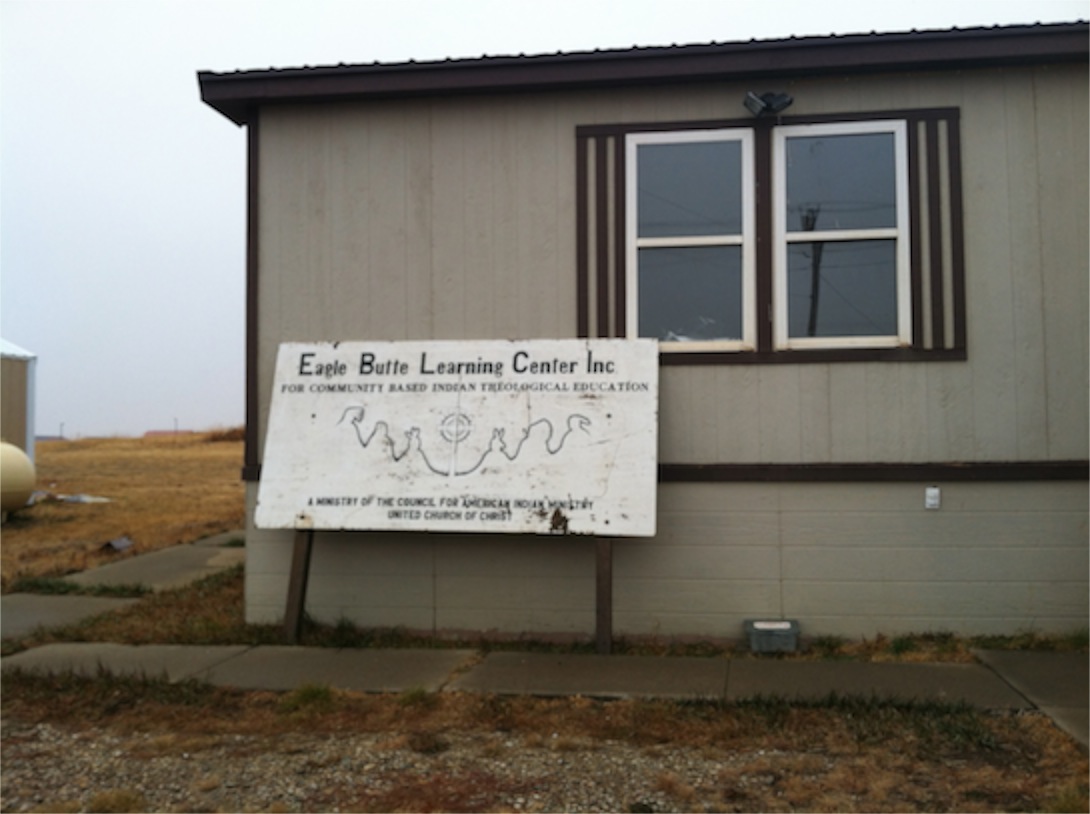
Cell phones do work in Eagle Butte. It is a good thing. It took a half dozen calls and a couple of text messages to connect with Louie Blue Coat, who has a key to let us into the Learning Center. It was noon our time (1 p.m. Central Time) when we arrived in Eagle Butte, so we had our lunch while we waited for our friends to arrive.
There is a wheelchair ramp at the Learning Center, and we had brought a dolly, so we could roll the organ up the ramp and into the center. We didn’t have an organist with us, but we played a few chords to make sure that the organ was working. Rev. Norman Blue Coat arrived with his wife and great-granddaughter to greet us, so we visited for a while before heading towards home.
The first few miles were remarkably fog-free. We had good visibility until we were almost at Faith. Then we were back in the soup. We decided to take a rather convoluted route home and headed south from Faith back to Howe’s Corner and then west towards Sturgis. A bit past Union Center, which we could see in the afternoon, we turned on New Underwood Road, headed south to New Underwood and came the last 25 miles into town on the Interstate from the east. We pulled into the church parking lot at about 4:30 p.m. The fog hadn’t slowed us much. We had anticipated that it might be 5 or even later when we returned.
A couple of minutes later, the trailer was parked and I was home in time to read for a half hour before supper.
From time to time it seems to give me energy and renewal to just leave town and drive across the prairie. Sometimes I say it is because I like the scenery, which I do, but there was little to be seen yesterday in the fog. I think that there is something about unplugging and disconnecting from our normal hyper-connected world. Aside from a few calls and messages to make contact with our friends in Eagle Butte, I ignored the phone, e-mails and messages all day long. Traffic is never very heavy on the roads we were driving and we had the gravel roads to ourselves. I love working with people and I enjoy my job a lot, but there are days when it is a treat to not have to do too much talking. A person can feel small out in the middle of the prairie.
It was a great way to begin the month of November.
Copyright © 2012 by Ted Huffman. I wrote this. If you want to copy it, please ask for permission. There is a contact me button at the bottom of this page. If you want to share my blog a friend, please direct your friend to my web site.
All Saints 2012

I’m not sure how a relatively minor holiday got so much attention, but it is fair to say that our culture is vastly different from that of other eras and locations. In the life of the church, the real holiday is today: All Saints Day. On this day we remember those who have gone before whose gifts and talents have shown us how to live. The night before the feast of All Saints became known as All Hallow’s Eve which eventually got shortened into Halloween.
We have a fascination with death, and wonder what it means and how it might be and Halloween gave some opportunity to explore the mystery of death. Skeletons and spirits seemed to be symbols of the reality of death. The incorporation of pumpkins, corn stalks and other vestiges of harvest festivals was natural because of the timing of the holiday.
I suspect, however, that the children rushing from house to house on West Boulevard last night didn’t have many thoughts of death as they filled their bags with candy while showing off their costumes. I didn’t witness any people facing their fears as they participated in the tradition and ritual of the evening.
Even the older teens who were still out enjoying the warm autumn evening as I drove home weren’t engaging in anything that was likely to get them to think about their own mortality and the meaning of life and death. They were stocking up on snack foods at the few homes that still had their porch lights turned on.
Teens, of course, do think about death and the meaning of life, though not always at the same time. Their world is filled with images of death in video games, movies and television. They have experienced more gory scenes and seen more portrayal of horrible death than I could even imagine. Their experiences, however, are usually in the context of knowing that “it is only a game.” The deaths they witness are not real to them. And movies and games rarely depict the pain and grief of death. The closest that the script writers come to grief is a rage that seeks revenge. Real life doesn’t work like the movies or video games. In real life there is real pain. In real life death is permanent.
We still need opportunities to engage our children and youth in conversation and learning about life and death, but Halloween seems like an unlikely occasion for such. I try to remain open to all of the teachable moments in the lives of those around me, and I’m not ruling out a conversation about such topics on Halloween some day, but it seems like all of the trappings of the way we celebrate the occasion in contemporary society get in the way of serious contemplation of the meanings of life.
The little ones consume far too much sugar on Halloween evening to be able to focus their energies and attention. The costumes lend a sense of “make believe” and unreality to the occasion.
I’m not trying to shift the culture. I’m not even upset at the way that Halloween has evolved in our society. I just am aware that the secularized holiday often falls short of the deeper meaning that is a part of All Saints Day.
I’ve written it in this blog over and over again: we belong to something much bigger than ourselves. The lives of those who have died continue to affect the lives we live. Our lives play a role in the lives of future generations. We belong to a long line of history making. Like the parade of children going up and down the boulevard last night, we are not the beginning nor are we the end of the generations of this earth.
Some of those lives that went before our own have a great deal to teach us about the nature of a life well lived. Some of those lives are worth examining for clues about how to live our own lives.

You are not alone. The saints are with us every day. Today is a good day to clebrate that reality. Happy All Saints Day!